Home » Search results for 'sip' (Page 50)
Search Results for: sip
Introducing the Orgasmatron V, Google Voice Edition
 It's been an interesting couple of weeks watching many of our readers flock to Google Voice in order to make free calls in the U.S. and Canada. The only problem with our Google Voice solution was the skill set required to get everything humming along as it should. For those new to the Asterisk® world, it only made sense to create a special installer that would build an Instant PBX.
It's been an interesting couple of weeks watching many of our readers flock to Google Voice in order to make free calls in the U.S. and Canada. The only problem with our Google Voice solution was the skill set required to get everything humming along as it should. For those new to the Asterisk® world, it only made sense to create a special installer that would build an Instant PBX.
Check Out the Latest! The Incredible PBX
Coming January 19: Incredible PBX 11 & Incredible Fax for Asterisk 11 and FreePBX 2.11
In putting this together, we couldn't help noticing the dilemma posed on the new FreePBX web site: "Looking for Phone Service? We can't quite give you the phone service for the same price (free) as the PBX..." Well, maybe they can't, but we certainly can thanks to our friends at Google Voice. So today we're pleased to introduce the first Truly Free™ Asterisk PBX. If you've mastered slice-and-bake cookies, you'll have no trouble with today's recipe.
Welcome to the Orgasmatron V Installer, the wonderscript that lets you create a turnkey Asterisk system with free U.S. and Canada calling through Google Voice in less than 15 minutes! When you're finished you'll have a PBX in a Flash system with every bell and whistle on the planet. Not only is the PBX absolutely free but so are all of your outbound and incoming calls throughout the United States and Canada. All you'll need is an Internet connection and any garden variety PC that's less than 3 years old. Or you can splurge and buy yourself a new Atom-based PC or NetBook and have a state-of-the-art PBX that may last you close to a decade. While you'll still need to change a few passwords and plug in some phones, the Orgasmatron V build reduces the Asterisk learning curve to almost zero. Out of the box, email works. Faxing works. ENUM works. And free calling in the U.S. and Canada works. Just plug in your Google Voice credentials, and you can start placing calls to every phone in the U.S. and Canada for free in just a few minutes.
For those that are wondering what's included in the Orgasmatron V build, here's a feature list of the components you get in addition to the base PBX in a Flash build with Asterisk 1.4, FreePBX 2.5, and Apache, SendMail, MySQL, PHP, phpMyAdmin, IPtables Linux firewall, Fail2Ban, and WebMin:
- AsteriDex
- CallerID Superfecta (FreePBX Module)
- CallWho for Asterisk
- Cepstral TTS (installer script only)
- Email That Works with SendMail
- Extensions (15 preconfigured)
- Fax Module using nvFax
- FONmail
- FreePBX Backups
- Gizmo5 (FreePBX Module)
- Google Voice (preconfigured)
- Hamachi VPN (installer script only)
- Hotel-Style Wakeup Calls (FreePBX Module)
- ISN: Free SIP Calling from Any Phone
- MeetMe Conferences
- Mondo Full System Backups
- NewsClips from Yahoo
- ODBC Database Support
- Reminders by Phone and Web
- SIP URI support (fax, mothership, e164, nv-demo, gv-ringback)
- TeleYapper
- Tide Reports with xTide
- Trunk Lister Script
- Trunks (Vitelity, Fonica, Gizmo, ENUM, Remote Peer)
- Weather by Airport Code
- Weather by ZIP Code
- Worldwide Weather
- Zaptel Updater (script only)
Getting Started. Even though the installation process is now a No-Brainer, you are well-advised to do some reading before you begin. VoIP PBX systems have become a favorite target of the hackers and crackers around the world and, unless you have an unlimited bank account, you need to take some precautions to protect your phone bill. Start by reading our Primer on Asterisk Security. Then read our PBX in a Flash and VPN in a Flash knols. If you're still not asleep, there's loads of additional documentation on the PBX in a Flash documentation web site.
Prerequisites. You obviously still need a free Google Voice account. If you don't have one, you can request an invite here. At last report, it's only taking a few days from application to invite which is really great news. Don't use a space in your Google Voice password! Once you have a Google Voice account and phone number (Google has reserved several million of them so... not to worry!), then you'll need a DID that provides unlimited, free incoming calls. We'll use it as your Google Voice RingBack DID and will explain all of this after we get your PBX up and running. We'd recommend a free IPkall or SIPgate DID, but we'll get to that.
Installation. Here's a quick tutorial to get you going. First, install the 32-bit, Asterisk 1.4 version of PBX in a Flash. Boot your system from the installation CD and type ksalt to begin. As your machine reboots, remove the CD and choose option A to load the most stable payload. When the install completes, reboot your system once again and login as root with the password you chose when you built your system. Now issue the following commands to bring your system current and protect your system passwords: update-scripts, update-fixes, passwd-master. You now have a PBX in a Flash base install. On a stand-alone machine, it takes about 30 minutes. On a virtual machine, it takes about half that time.
Now you're ready to run the Orgasmatron V Installer. While still logged into your new server as root, issue the following commands:
cd /root
wget http://pbxinaflash.net/orgasmatron/orgasmatron-gv.x
chmod +x orgasmatron-gv.x
./orgasmatron-gv.x
reboot
Stick around while the install script is running. Parts of it are interactive. For now, choose the Flite option when you're prompted twice for your text-to-speech preferences. That way you'll have a working system when you're finished. Once the Orgasmatron V installer script is finished, type status and write down the IP address of your server. You'll need it in the next step to log into FreePBX.
If you'd prefer to pick and choose the apps to install, use this fully-interactive installer instead:
cd /root
wget http://pbxinaflash.net/orgasmatron/orgasmatron-interactive.x
chmod +x orgasmatron-interactive.x
./orgasmatron-interactive.x
reboot
Using a web browser, open FreePBX on your new server with a command like this (substituting the IP address you wrote down above). When prompted for your account name, type maint and use the password you assigned when running passwd-master above:
http://192.168.0.123/admin/
You're NOT done yet!
These next three steps are important. They get all of the FreePBX modules installed and then restore the FreePBX backup set that's at the heart of the Orgasmatron build. Just follow along here. If you're using the new OpenVZ template for PBX in a Flash, start at step 3 and then complete step 1 and 2. Otherwise...
1. Choose Module Admin, Check for Updates online, Upgrade All, Process, Confirm, Return, Apply Config Changes, Continue.
2. Choose Module Admin, Check for Updates online, Download All, Process, Confirm, Return, Apply Config Changes, Continue.
3. Click on the Tools tab and choose Backup & Restore, Restore, RightNow, and select the .tar.gz file that is displayed. Then choose Restore Entire Backup Set, OK, Apply Config Changes, and Continue.
Securing Your System. You're almost done. We always like to reboot the server just to make sure nothing got lost in the shuffle. When the reboot is finished, log into FreePBX with a browser again. Before you do anything else, choose each of the 16 preconfigured extensions on your new server and change the extension AND voicemail passwords. Here's the drill: Setup, Extensions, 501, Submit after changing secret and Voicemail Password. Repeat with the next extension number instead of 501. Then Apply Config Changes, Continue when you've finished with all of them.
Now let's change the default DISA password: Setup, DISA, DISAmain, PIN, Submit Changes, Apply Config Changes, Continue. Whew! Your system now is relatively secure. Follow the steps in the tutorials we recommended, and you're ready to experiment. Plug in a couple of SIP phones or softphones and configure them using the available extensions (701-715) together with the secrets for those extensions. Place a test call between the extensions to make sure you have a working PBX. Now we're ready to add the pieces so that people from outside your system can call you and so that you can call them as well.
Setting Up An IPkall RingBack DID. Step #1 is obtaining a free DID which will be used to handle RingBack calls from Google Voice. If you're new to Google Voice, here's a quick primer. Whenever you place an outbound call through Google Voice, GV actually places two calls. It returns your call to a number you designate as your RingBack number, and then GV places the call to the destination number you've chosen. We will transparently merge the two calls together behind the scenes so the caller will think it's a "normal" long distance call. But, before Google Voice calling will work with Asterisk, you'll need another DID (in addition to your new Google Voice number) to transparently handle these RingBack calls into Asterisk.
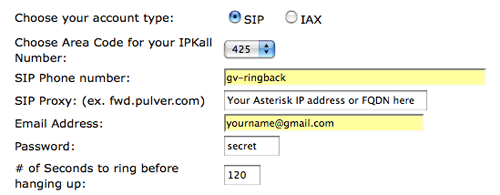
 Shown above is the IPkall request form to sign up for a free DID. Make your form look like the one above but change 3 pieces of information: (1) the SIP Proxy which is the public IP address of your Asterisk server or its fully-qualified domain name, (2) a working Email Address which will be used to confirm your request for a free DID, and (3) a password to protect your DID at IPkall. Leave the other entries the way they're shown, especially the SIP Phone Number, gv-ringback, which is preconfigured to route incoming SIP calls on your new PBX to any phones connected to extensions 701-715. Once you have confirmed your request by email, you will be assigned a phone number. Assuming you've already connected a phone to your new PBX on one of the above extensions, it should ring when you call your new IPkall number. Don't proceed until you get this working because it must be functional before you can complete the set up of your Google Voice account.
Shown above is the IPkall request form to sign up for a free DID. Make your form look like the one above but change 3 pieces of information: (1) the SIP Proxy which is the public IP address of your Asterisk server or its fully-qualified domain name, (2) a working Email Address which will be used to confirm your request for a free DID, and (3) a password to protect your DID at IPkall. Leave the other entries the way they're shown, especially the SIP Phone Number, gv-ringback, which is preconfigured to route incoming SIP calls on your new PBX to any phones connected to extensions 701-715. Once you have confirmed your request by email, you will be assigned a phone number. Assuming you've already connected a phone to your new PBX on one of the above extensions, it should ring when you call your new IPkall number. Don't proceed until you get this working because it must be functional before you can complete the set up of your Google Voice account.
Setting Up A SIPgate RingBack DID. If you elect to use a SIPgate DID, the process is a bit more complicated. Once you've registered for a free DID on their site, you'll get an email with your credentials. You then will need to create a new trunk using FreePBX with the following entries replacing SIP-ID and SIP-Password with your actual credentials. Use sipgate for the Trunk Name and fill in the following in the Outgoing Settings section of the form:
type=peer
username=SIP-ID
fromuser=SIP-ID
secret=SIP-Password
context=from-trunk
host=sipgate.com
fromdomain=sipgate.com
insecure=very
caninvite=no
canreinvite=no
nat=no
disallow=all
allow=ulaw&alaw
Leave the Incoming Settings blank, and enter the following Registration String using your actual credentials:
Save your entries and then create an Inbound Route called sipgate. Enter your 10-digit SIPgate number in the DID Number field and choose Ring Group: 700 as the Destination for the inbound calls to this number. Reload your Asterisk dialplan when prompted to do so. Connect a phone to an extension on your PBX and be sure the phone rings when you call your new SIPgate DID number before proceeding.
 Google Voice Setup. Once you get your RingBack DID set up on your Asterisk system, we need to configure your new Google Voice account. Log into your GV account and click Settings, Phones, Add Another Phone. Add the area code and phone number of your RingBack DID. Be sure a phone is connected to one of the existing extensions (701-715) on your PBX since you have to go through Google's confirmation drill to successfully register the number with GV. After the DID is confirmed, be sure there's a check mark beside this Google Voice destination so that incoming calls to your GV number will be routed to your Asterisk server.
Google Voice Setup. Once you get your RingBack DID set up on your Asterisk system, we need to configure your new Google Voice account. Log into your GV account and click Settings, Phones, Add Another Phone. Add the area code and phone number of your RingBack DID. Be sure a phone is connected to one of the existing extensions (701-715) on your PBX since you have to go through Google's confirmation drill to successfully register the number with GV. After the DID is confirmed, be sure there's a check mark beside this Google Voice destination so that incoming calls to your GV number will be routed to your Asterisk server.
While you're still in the Google Voice Setup, click on the General tab. Uncheck Enable Call Screening. Turn Call Presentation Off. And set CallerID to Display Caller's Number. Remember NOT to include a space in your Google Voice password! Finally, uncheck Do Not Disturb. Now click the Save Changes button.
Adding Your GV Credentials to PBX in a Flash. Now we're ready to insert your Google Voice credentials into PBX in a Flash. You'll need four pieces of information: your 10-digit Google Voice phone number, your Google Voice account name (which is the email address you used to set up your GV account), your GV password (no spaces!), and your 11-digit RingBack DID (beginning with a 1) from either IPkall or SIPgate. Don't get the 10-digit GV number mixed up with the 11-digit RingBack DID, or nothing will work. 🙂 Now log back into your server as root and issue the following commands. Check your entries carefully. If you make a typo in entering any of your data, press Ctrl-C to cancel the script and then run it again!!
cd /root
wget http://pbxinaflash.net/orgasmatron/configure-gv
chmod +x configure-gv
./configure-gv
Updating pyGoogleVoice. Since this article was initially released, Google has made some changes in the way Google Voice processes incoming calls. To address this, you'll need to update the version of pyGoogleVoice installed with this build. While still logged into your server as root, issue the following commands:
cd /root
wget http://pygooglevoice.googlecode.com/files/pygooglevoice-0.5.tar.gz
tar zxvf pygooglevoice-0.5*
cd pygooglevoice-0.5
python setup.py install
Modifying Your RingBack Inbound Route. The last step in the setup process is to reroute your gv-ringback incoming route so that it points to a custom context to process your Google Voice ringback calls transparently. Log back into FreePBX with a web browser and choose Setup, Inbound Routes, gv-ringback. Change the Destination for these calls to Custom Destinations: Custom GV-Park. If you're using SIPgate instead of IPkall, be sure to change the other settings to look like this:
Description: gv-ringback
DIDNumber: *Your 10-digit-SIPgate-Number*
CallerId: *Your 10-digit-Google-Voice-Number*
Save your changes by clicking the Submit button and then reload your dialplan when prompted.
Choosing a VoIP Provider. For this week, we'll point you to some things to play with on your new server. Then, in the subsequent articles below, we'll cover in detail how to customize every application that's been loaded. Nothing beats free when it comes to long distance calls. But nothing lasts forever. So we'd recommend you set up another account with Vitelity using our special link below. This gives your PBX a secondary way to communicate with every telephone in the world, and it also gets you a second real phone number for your new system... so that people can call you. Here's how it works. You pay Vitelity a deposit for phone service. They then will bill you $3.99 a month for your new phone number. This $3.99 also covers the cost of unlimited inbound calls (two at a time) delivered to your PBX for the month. For outbound calls, you pay by the minute and the cost is determined by where you're calling. If you're in the U.S., outbound calls to anywhere in the U.S. are a little over a penny a minute. If you change your mind about Vitelity and want a refund of the balance in your account, all you have to do is ask.
The VoIP world is new territory for some of you. Unlike the Ma Bell days, there's really no reason not to have multiple VoIP providers especially for outbound calls. Depending upon where you are calling, calls may be cheaper using different providers for calls to different locations. So we recommend having at least two providers. Visit the PBX in a Flash Forum to get some ideas on choosing alternative providers.
Kicking the Tires. OK. That's enough tutorial for today. Let's play. After you've connected a phone to your new system, begin your adventure by dialing these 10 numbers:
- D-E-M-O - Check out the Nerd Vittles Orgasmatron Demo
- Z-I-P - Enter a five digit zip code for any U.S. weather report
- 6-1-1 - Enter a 3-character airport code for any U.S. weather report
- 5-1-1 - Get the latest news and sports headlines from Yahoo News
- T-I-D-E - Get today's tides and lunar schedule for any U.S. port
- F-A-X - Send a fax to an email address of your choice
- 4-1-2 - 3-character phonebook lookup/dialer with AsteriDex
- M-A-I-L - Record a message and deliver it to any email address
- C-O-N-F - Set up a MeetMe Conference on the fly
- 1-2-3 - Schedule a regular or recurring phone reminder
- Dial *68 - Schedule a hotel-style wakeup call on any extension
Google Voice Speed Dials. For frequently called numbers, you can add speed dials by inserting entries in the [from-internal-custom] context of extensions_custom.conf in the /etc/asterisk folder that look like the example below where 333 is the speed dial number and 6781234567 is the area code and number to call. Be sure to reload your Asterisk dialplan to activate them.
exten => 333,1,Dial(local/6781234567@custom-gv,300)
Congratulations! You now have what we hope will be flawless and free U.S. calling on your Asterisk system using Google Voice. No gimmicks, no strings, no cost. Enjoy!
Finally, one additional word of caution. Both Google Voice and this call design are set up for a single call at a time. There are no safeguards to prevent multiple calls, but that may violate the Google Voice terms of service.
Homework. Your homework for this week is to do some exploring. FreePBX is a treasure trove of functionality, and the Orgasmatron build adds a bunch of additional options. See if you can find all of them. Then log into your server as root and look through the scripts added in the /root/nv folder. You'll find all sorts of goodies to keep you busy. Enjoy!
whos.amung.us If you're wondering what your fellow man is reading on Nerd Vittles these days, wonder no more. Visit our new whos.amung.us statistical web site and check out what's happening. It's a terrific resource both for us and for you.

Need help with Asterisk? Visit the PBX in a Flash Forum.
Or Try the New, Free PBX in a Flash Conference Bridge.
Special Thanks to Our Generous Sponsors
FULL DISCLOSURE: ClearlyIP, Skyetel, Vitelity, DigitalOcean, Vultr, VoIP.ms, 3CX, Sangoma, TelecomsXchange and VitalPBX have provided financial support to Nerd Vittles and our open source projects through advertising, referral revenue, and/or merchandise. As an Amazon Associate and Best Buy Affiliate, we also earn from qualifying purchases. We’ve chosen these providers not the other way around. Our decisions are based upon their corporate reputation and the quality of their offerings and pricing. Our recommendations regarding technology are reached without regard to financial compensation except in situations in which comparable products at comparable pricing are available from multiple sources. In this limited case, we support our sponsors because our sponsors support us.
 BOGO Bonaza: Enjoy state-of-the-art VoIP service with a $10 credit and half-price SIP service on up to $500 of Skyetel trunking with free number porting when you fund your Skyetel account. No limits on number of simultaneous calls. Quadruple data center redundancy. $25 monthly minimum spend required. Tutorial and sign up details are here.
BOGO Bonaza: Enjoy state-of-the-art VoIP service with a $10 credit and half-price SIP service on up to $500 of Skyetel trunking with free number porting when you fund your Skyetel account. No limits on number of simultaneous calls. Quadruple data center redundancy. $25 monthly minimum spend required. Tutorial and sign up details are here.
 The lynchpin of Incredible PBX 2020 and beyond is ClearlyIP components which bring management of FreePBX modules and SIP phone integration to a level never before available with any other Asterisk distribution. And now you can configure and reconfigure your new Incredible PBX phones from the convenience of the Incredible PBX GUI.
The lynchpin of Incredible PBX 2020 and beyond is ClearlyIP components which bring management of FreePBX modules and SIP phone integration to a level never before available with any other Asterisk distribution. And now you can configure and reconfigure your new Incredible PBX phones from the convenience of the Incredible PBX GUI.
 VitalPBX is perhaps the fastest-growing PBX offering based upon Asterisk with an installed presence in more than 100 countries worldwide. VitalPBX has generously provided a customized White Label version of Incredible PBX tailored for use with all Incredible PBX and VitalPBX custom applications. Follow this link for a free test drive!
VitalPBX is perhaps the fastest-growing PBX offering based upon Asterisk with an installed presence in more than 100 countries worldwide. VitalPBX has generously provided a customized White Label version of Incredible PBX tailored for use with all Incredible PBX and VitalPBX custom applications. Follow this link for a free test drive!
 Special Thanks to Vitelity. Vitelity is now Voyant Communications and has halted new registrations for the time being. Our special thanks to Vitelity for their unwavering financial support over many years and to the many Nerd Vittles readers who continue to enjoy the benefits of their service offerings. We will keep everyone posted on further developments.
Special Thanks to Vitelity. Vitelity is now Voyant Communications and has halted new registrations for the time being. Our special thanks to Vitelity for their unwavering financial support over many years and to the many Nerd Vittles readers who continue to enjoy the benefits of their service offerings. We will keep everyone posted on further developments.
Some Recent Nerd Vittles Articles of Interest...
Tweaking Asterisk for Free Google Voice Calling
 Now that the Asterisk® and Google Voice marriage is finally underway, we wanted to step back today and revise the original methodology a bit to take advantage of some of the terrific comments which were offered in response to our last article. First, the good news. U.S. calls through Google Voice using Asterisk work! They sound great, and they're free. The not so good news was that the MeetMe conferencing trick to join your outbound call with the Google Voice click-to-dial return call from your destination worked great so long as a real person answered the phone. But, if an answering machine picked up or no one answered the call at all, there were problems because these calls already had been transferred to the MeetMe conference and there was no simple way to disconnect them. And the need for two DIDs to support a single Google Voice interface just seemed a bit wasteful.
Now that the Asterisk® and Google Voice marriage is finally underway, we wanted to step back today and revise the original methodology a bit to take advantage of some of the terrific comments which were offered in response to our last article. First, the good news. U.S. calls through Google Voice using Asterisk work! They sound great, and they're free. The not so good news was that the MeetMe conferencing trick to join your outbound call with the Google Voice click-to-dial return call from your destination worked great so long as a real person answered the phone. But, if an answering machine picked up or no one answered the call at all, there were problems because these calls already had been transferred to the MeetMe conference and there was no simple way to disconnect them. And the need for two DIDs to support a single Google Voice interface just seemed a bit wasteful.
9/1/2010 Update: A good bit has changed with Google Voice since this article was first published. For the definitive guide and installation procedure, we highly recommend The Incredible PBX and accompanying article which can be found at this link. Google Voice (and much more) already is included in our new PBX which is literally Plug-and-Play. If you prefer to roll your own, be sure to also have a look at this excellent update on the Michigan Telephone Blog.
Today we want to try to eliminate these two quirks while stiill providing a seamless interface between Google Voice and Asterisk. We also appreciate that thousands of you already have implemented the previous approach. So we want your transition to the new way of doing things to be as painless as possible. On the other hand, for frequent readers, we hope you'll bear with us as we repeat some of what already has been covered in previous articles so new visitors don't have to jump around between articles to get the complete picture of what we're trying to accomplish.
The objective remains the same. We want a methodology that lets us make outbound calls from any Asterisk phone using the Google Voice service to take advantage of free calling in the United States and Canada. And we want calls to our Google Voice number delivered to our Asterisk system for transparent call processing. Yes, SIP is still on our wish list for both outbound and inbound calls with Google Voice, but we'll make do with PSTN calls particularly while Google is footing the bill for all of the calls.
Update: There's now a turnkey Asterisk solution that implements Google Voice calling without getting your hands dirty. Check out our new Orgasmatron V.
 Tweaked Design. Here's the new design. You obviously still need a free Google Voice account. If you don't have one, you can request an invite here. At last report, it's only taking a few days from application to invite which is really great news. Don't use a space in your Google Voice password! Once you have a Google Voice account and phone number (Google has reserved a million of them so... not to worry!), then you'll need a DID that provides unlimited, free incoming calls. Once you get your DID set up on your Asterisk system, we'll set up a forwarding phone number for this DID in your Google Voice account so that Google Voice calls can be connected to your Asterisk server.
Tweaked Design. Here's the new design. You obviously still need a free Google Voice account. If you don't have one, you can request an invite here. At last report, it's only taking a few days from application to invite which is really great news. Don't use a space in your Google Voice password! Once you have a Google Voice account and phone number (Google has reserved a million of them so... not to worry!), then you'll need a DID that provides unlimited, free incoming calls. Once you get your DID set up on your Asterisk system, we'll set up a forwarding phone number for this DID in your Google Voice account so that Google Voice calls can be connected to your Asterisk server.
For outbound calls, we'll combine a little dialplan voodoo with pygooglevoice to instruct Asterisk to place a click-to-dial call using your Google Voice forwarding number. Then we'll stuff in the destination U.S. phone number. When you dial GV-678-1234567 from any of your Asterisk phones, Asterisk will park your initial call in a reserved parking lot slot and then join the called party to the originally parked call. The entire procedure is virtually transparent both to the caller and the callee. And, unlike the MeetMe conference, the parking lot fades out of the picture as soon as the call is connected. Thus, if either party hangs up, the active channel for the call is terminated on your Asterisk server.
For inbound calls from your Google Voice number, we'll tweak the dialplan so that it can distinguish between a RingBack call that Google Voice initiated and a true inbound call. We'll peel off the real inbound calls and route them to a separate Inbound Route in FreePBX for processing in any way you desire.
Finally, for those that implemented the methodology in our previous article, we'll walk you through the steps to revise your existing setup to take advantage of these new tweaks. You can skip over the initial installation process if you already have gone through the Google Voice setup from our earlier article. Just skip down to Tweaking Previous Setups.
 Special Thanks. At the outset, we again want to express our sincere appreciation to Jacob Feisley and Paul Marks for their pioneering work on a Python interface to Google Voice. We also stumbled upon another Python development project, Google Voice for Python. While we originally had planned to rely upon Jacob and Paul's script, we ultimately decided to implement pygooglevoice because of the additional flexibility it provided for down the road. With pygooglevoice, you not only can make Google Voice calls, but you also can send SMS messages with no muss or fuss. Jacob Feisley has now joined that project as well. So, our special tip of the hat goes to the entire Google Voice for Python development team. It's a terrific product as you will see.
Special Thanks. At the outset, we again want to express our sincere appreciation to Jacob Feisley and Paul Marks for their pioneering work on a Python interface to Google Voice. We also stumbled upon another Python development project, Google Voice for Python. While we originally had planned to rely upon Jacob and Paul's script, we ultimately decided to implement pygooglevoice because of the additional flexibility it provided for down the road. With pygooglevoice, you not only can make Google Voice calls, but you also can send SMS messages with no muss or fuss. Jacob Feisley has now joined that project as well. So, our special tip of the hat goes to the entire Google Voice for Python development team. It's a terrific product as you will see.
Prerequisites. Today's setup requires a CentOS-based Asterisk aggregation with a current version of FreePBX. Be aware that today's solution requires Python 2.4 or higher and reportedly will not work with Python 2.3 found in some Linux distributions. We've tested everything with PBX in a Flash and, on that platform, you're good to go. The install script should work equally well with the other CentOS-based Asterisk aggregations, but we haven't tested them. Be our guest, and let us know if you encounter any problems. Finally, a word of caution. We don't ordinarily distribute solutions using development tools we don't use. Our knowledge of Python wouldn't fill a thimble. We've made an exception today because of the extraordinary interest in Google Voice by the Asterisk community. But, if something comes unglued, we can't fix it. So have a backup plan in place just in case. 🙂
Today's Drill. To get everything working today, there are six steps: (1) obtaining and configuring a DID to manage calls between Google Voice and Asterisk, (2) configuring a Google Voice forwarding number for this DID to manage your outbound and inbound calls, (3) configuring FreePBX to route all outbound calls with a GV prefix to your special Google Voice dialplan context, (4) configuring an inbound route to manage incoming calls from your Google Voice number, (5) setting up a series of Parked Call extensions, one of which will be used to manage your outbound Google Voice calls, and (6) running our install script which adds the dialplan code for Google Voice calling with your credentials and puts the Python application into place on your server. It sounds more complicated than it is. So hang on to your hat. Here we go!
 Dedicated DID. Before you can use Google Voice with Asterisk, you'll need a DID that can be dedicated to your Google Voice interface to Asterisk. We'd recommend a free IPkall or SIPgate DID. To get started, use one of the links above to obtain and configure the DID. Temporarily point the DID to an extension on your Asterisk system that can be used to verify your requests for the number. Since all of these calls are free, the area code of the DID really doesn't matter because you're never going to publish the fact that it exists.
Dedicated DID. Before you can use Google Voice with Asterisk, you'll need a DID that can be dedicated to your Google Voice interface to Asterisk. We'd recommend a free IPkall or SIPgate DID. To get started, use one of the links above to obtain and configure the DID. Temporarily point the DID to an extension on your Asterisk system that can be used to verify your requests for the number. Since all of these calls are free, the area code of the DID really doesn't matter because you're never going to publish the fact that it exists.
The easiest method for setting up the DID is to first create a SIP URI for the DID on your Asterisk system. Next route the SIP URI to an Inbound Route in FreePBX where you can manage the destination for calls to that DID. Initially, you want the destination to be an extension on your Asterisk system that you can answer to verify both the DID setup and the GV setup below. Finally, point the DID you obtained to the SIP URI defined above.
HINT: The entry in extensions_override_freepbx.conf would look something like this for a SIP URI called ipkall-1:
exten => ipkall-1,1,Goto(from-trunk,${DID},1)
Then you would create an inbound route named ipkall-1 using FreePBX and designate some existing extension on your server as the destination for these inbound calls.
When you set up the SIP forwarding for the DID at ipkall.com, you'd specify the SIP URI as:
ipkall-1@ipaddress_of_your-Asterisk_server
We've previously covered in detail how to do this so read the article if you need a refresher course. To reiterate, the area code of this DID really doesn't matter because you're never going to give out the number. So use one of the free sources and save yourself some money. The real trick is you want to use a DID with unlimited, free inbound calls. Both IPkall and SIPgate provide that functionality at no cost.
 Google Voice Setup. Log into your Google Voice account and click Settings, Phones, Add Another Phone. Add the area code and phone number of your DID. Be sure the DID is pointed to an extension on your PBX that you can answer since you have to go through Google's confirmation drill to successfully register the number. After the DID is confirmed, be sure there's a check mark beside this Google Voice destination so that incoming calls to your GV number will be routed to your Asterisk server.
Google Voice Setup. Log into your Google Voice account and click Settings, Phones, Add Another Phone. Add the area code and phone number of your DID. Be sure the DID is pointed to an extension on your PBX that you can answer since you have to go through Google's confirmation drill to successfully register the number. After the DID is confirmed, be sure there's a check mark beside this Google Voice destination so that incoming calls to your GV number will be routed to your Asterisk server.
While you're still in the Google Voice Setup, click on the General tab. Uncheck Enable Call Screening. Turn Call Presentation Off. And set CallerID to Display Caller's Number. Be aware that IPkall DIDs only forward your IPkall number as the CallerID number while SIPgate DIDs reportedly forward the actual number of the person calling you. If this matters to you, then you may prefer the SIPgate DID option. Finally, uncheck Do Not Disturb. Now click the Save Changes button.
Integrating Google Voice into Asterisk with FreePBX. Open FreePBX with a web browser and choose Setup, Trunks, Add Custom Trunk. Insert your GV number in the Outbound CallerID field and add the following Custom Dial String on the form and Submit Changes and reload the dialplan:
local/$OUTNUM$@custom-gv
Next, choose Setup, Outbound Routes, Add Route and fill in the following entries on the form:
Route Name: GoogleVoice
Dial Pattern: 48|NXXNXXXXXX
Trunk Seq: local/$OUTNUM$@custom-gv
 Inbound Routes. Next, we need two Inbound Routes to get everything working. In setting up your DID with IPkall or SIPgate, you already should have created one inbound route for that provider. It already should be routing calls to an extension on your PBX. Now we need to create a Custom Destination for this inbound route and then reroute these calls there. In that way, your RingBack calls will be routed to some special dialplan code that drops these calls into a custom parking lot where the RingBack call is married up to the extension from which you placed the original call. Then we need to create another inbound route to manage normal incoming calls that are forwarded to your PBX whenever someone dials your Google Voice number.
Inbound Routes. Next, we need two Inbound Routes to get everything working. In setting up your DID with IPkall or SIPgate, you already should have created one inbound route for that provider. It already should be routing calls to an extension on your PBX. Now we need to create a Custom Destination for this inbound route and then reroute these calls there. In that way, your RingBack calls will be routed to some special dialplan code that drops these calls into a custom parking lot where the RingBack call is married up to the extension from which you placed the original call. Then we need to create another inbound route to manage normal incoming calls that are forwarded to your PBX whenever someone dials your Google Voice number.
To begin, choose Tools, Custom Destinations, Add Custom Destination and add an entry like this and then click the Submit Changes button:
Custom Destination: custom-park,s,1
Description: Custom GV-Park
Next choose Setup, Inbound Route and click on the inbound route you created previously for IPkall or SIPgate. Change the destination for these calls to Custom Destination: Custom GV-Park.
Now click on Add Incoming Route and create a new route for your incoming Google Voice calls. Give it any description you like but, for the DID number, it must be gv-incoming. You can leave most of the other defaults. Just be sure you set a destination for your incoming calls from Google Voice. It could be an extension, ring group, IVR, or whatever best meets your needs. The important entry here is gv-incoming for the DID number. Click the Submit button to save your entries. Ignore the warning that you've entered an oddball DID. We know what we're doing. 🙂
 Setting Up the Parking Lot. While still in FreePBX, we need to create or adjust your existing settings in Setup, Parking Lot. The parking lot is used by FreePBX to simulate old key telephones where you could place a call on hold and then someone else in the office could pick up the call by clicking on the blinking key on their phone. The Asterisk equivalent is to press the flash hook and dial your Parking Lot Extension which then places the call in a Parking Lot space and tells you what the space number is. Someone else then can dial the number of that space to pick up the call. Our little trick today works like this. When you place an outbound call through Google Voice, your extension will be dumped into a reserved parking lot space. When Google Voice initiates the RingBack call before connecting the destination number you've dialed, that call will be sent to the same reserved parking lot space. The two calls then are joined, and you'll hear the parking lot number followed by ring tones as your call is connected by GV to its final destination. Our special thanks to Richard Bateman for his comment on the previous article and this terrific tip! He wins an Atomic Flash installer from Nerd Vittles. In addition, A. Godong wins an Atomic Flash installer for his tip on consolidating two DIDs into a single DID to manage both inbound and outbound GV calls. Just send us your addresses.
Setting Up the Parking Lot. While still in FreePBX, we need to create or adjust your existing settings in Setup, Parking Lot. The parking lot is used by FreePBX to simulate old key telephones where you could place a call on hold and then someone else in the office could pick up the call by clicking on the blinking key on their phone. The Asterisk equivalent is to press the flash hook and dial your Parking Lot Extension which then places the call in a Parking Lot space and tells you what the space number is. Someone else then can dial the number of that space to pick up the call. Our little trick today works like this. When you place an outbound call through Google Voice, your extension will be dumped into a reserved parking lot space. When Google Voice initiates the RingBack call before connecting the destination number you've dialed, that call will be sent to the same reserved parking lot space. The two calls then are joined, and you'll hear the parking lot number followed by ring tones as your call is connected by GV to its final destination. Our special thanks to Richard Bateman for his comment on the previous article and this terrific tip! He wins an Atomic Flash installer from Nerd Vittles. In addition, A. Godong wins an Atomic Flash installer for his tip on consolidating two DIDs into a single DID to manage both inbound and outbound GV calls. Just send us your addresses.
Now, where were we? Most FreePBX systems have a default setup for the Parking Lot. What we need to do is be sure you have reserved one more space in the parking lot than you actually need for day to day operation of your PBX. We'll use the last parking lot space number to manage outbound calling through Google Voice. Our entries look like the following:
Enable Parking Lot Feature: checked
Parking Lot Extension: 70
Number of Slots: 5
Parking Timeout: 30 seconds
Parking Lot Context: parkedcallsDestination for Orphaned Calls: Terminate Call: Hangup
If you use our setup above, the Magic Number is 75 which is the fifth slot in the Parking Lot. If you use a different Parking Lot extension or number of slots, here's how to calculate the Magic Number. Start counting the slots beginning with one more than the Parking Lot Extension. When you get to the last slot in the number of slots you've specified, that's your Parking Lot Magic Number. Write it down. You'll need it in a second when you run our GV installation script.
Save your entries and reload the Asterisk dialplan when prompted.
Integrating pygooglevoice. Now we're ready to complete the setup by running our revised script which loads pygooglevoice and sets up your dialplan in extensions_custom.conf. You'll need 5 pieces of information to run the script so write them down before you begin:
1. Your 10-digit Google Voice phone number
2. Your Google Voice email address
3. Your Google Voice password (no spaces!)
4. Your 11-digit RingBack DID (16781234567)
5. Your Parking Lot Magic Number
![]() A word of caution: If you used a gMail address to set up your Google Voice account, it's possible to have different gMail and Google Voice passwords. For this to work, you'll need to enter your gMail password, not your Google Voice password (assuming they're different).
A word of caution: If you used a gMail address to set up your Google Voice account, it's possible to have different gMail and Google Voice passwords. For this to work, you'll need to enter your gMail password, not your Google Voice password (assuming they're different).
Now log into your Asterisk server as root and issue the following commands:
cd /root
wget http://bestof.nerdvittles.com/applications/gv/install-gv-new
chmod +x install-gv-new
./install-gv-new
Google Voice Speed Dials. For frequently called numbers, you can add speed dials by inserting entries in the [from-internal-custom] context of extensions_custom.conf that look like the example below where 333 is the speed dial number and 6781234567 is the area code and number to call. Be sure to reload your Asterisk dialplan to activate them.
exten => 333,1,Dial(local/6781234567@custom-gv,300)
Congratulations! You now have what we hope will be flawless and free U.S. calling on your Asterisk system using Google Voice. No gimmicks, no strings, no cost. Enjoy!
Finally, one additional word of caution. Both Google Voice and this call design are set up for a single call at a time. There are no safeguards to prevent multiple calls, but that may violate the Google Voice terms of service.
Asterisk 1.6 Solution. Several readers now have documented the procedure for implementing the Asterisk 1.6 bridge technology to make outbound Google Voice calls. You can read all about it here.
 Tweaking Previous Setups. If you installed pygooglevoice using our previous tutorial, here's what you need to do. First, log into your Asterisk server as root and issue the following commands:
Tweaking Previous Setups. If you installed pygooglevoice using our previous tutorial, here's what you need to do. First, log into your Asterisk server as root and issue the following commands:
cd /etc/asterisk
nano -w extensions_custom.conf
Scroll to the bottom of the file by pressing Ctrl-W then Ctrl-V. Move up the file using up arrow until you reach [custom-gv]. Press Ctrl-K repeatedly to delete all of the lines in the [custom-gv] context. If you get to another line that starts with a label in brackets like [this], STOP deleting. Once you've deleted all of the lines in the [custom-gv] context, save the file: Ctrl-X, Y, and press Enter.
Now continue reading this article by jumping up to the Google Voice Setup topic. The Custom Trunk entry and the GoogleVoice outbound route will already be in your FreePBX system so there's no need to repeat those two steps. You will need to perform the remaining FreePBX steps beginning at the Inbound Routes topic and continuing on with Setting Up the Parking Lot. Finally, when you run the new installation script, it will detect that pygooglevoice is already on your system and will skip that step but will install the new custom contexts in extensions_custom.conf using your new settings. Enjoy!
Thought for the Day. Which is more arbitrary: (1) Apple snubs Google Voice or (2) Google Voice snubs SIP? Pays to look in the mirror occasionally.
Best Read of the Week. Memo to Steve Jobs and Apple: Stop Being A Jerk!

Need help with Asterisk? Visit the PBX in a Flash Forum.
Or Try the New, Free PBX in a Flash Conference Bridge.
whos.amung.us If you're wondering what your fellow man is reading on Nerd Vittles these days, wonder no more. Visit our new whos.amung.us statistical web site and check out what's happening. It's a terrific resource both for us and for you.
Special Thanks to Our Generous Sponsors
FULL DISCLOSURE: ClearlyIP, Skyetel, Vitelity, DigitalOcean, Vultr, VoIP.ms, 3CX, Sangoma, TelecomsXchange and VitalPBX have provided financial support to Nerd Vittles and our open source projects through advertising, referral revenue, and/or merchandise. As an Amazon Associate and Best Buy Affiliate, we also earn from qualifying purchases. We’ve chosen these providers not the other way around. Our decisions are based upon their corporate reputation and the quality of their offerings and pricing. Our recommendations regarding technology are reached without regard to financial compensation except in situations in which comparable products at comparable pricing are available from multiple sources. In this limited case, we support our sponsors because our sponsors support us.
 BOGO Bonaza: Enjoy state-of-the-art VoIP service with a $10 credit and half-price SIP service on up to $500 of Skyetel trunking with free number porting when you fund your Skyetel account. No limits on number of simultaneous calls. Quadruple data center redundancy. $25 monthly minimum spend required. Tutorial and sign up details are here.
BOGO Bonaza: Enjoy state-of-the-art VoIP service with a $10 credit and half-price SIP service on up to $500 of Skyetel trunking with free number porting when you fund your Skyetel account. No limits on number of simultaneous calls. Quadruple data center redundancy. $25 monthly minimum spend required. Tutorial and sign up details are here.
 The lynchpin of Incredible PBX 2020 and beyond is ClearlyIP components which bring management of FreePBX modules and SIP phone integration to a level never before available with any other Asterisk distribution. And now you can configure and reconfigure your new Incredible PBX phones from the convenience of the Incredible PBX GUI.
The lynchpin of Incredible PBX 2020 and beyond is ClearlyIP components which bring management of FreePBX modules and SIP phone integration to a level never before available with any other Asterisk distribution. And now you can configure and reconfigure your new Incredible PBX phones from the convenience of the Incredible PBX GUI.
 VitalPBX is perhaps the fastest-growing PBX offering based upon Asterisk with an installed presence in more than 100 countries worldwide. VitalPBX has generously provided a customized White Label version of Incredible PBX tailored for use with all Incredible PBX and VitalPBX custom applications. Follow this link for a free test drive!
VitalPBX is perhaps the fastest-growing PBX offering based upon Asterisk with an installed presence in more than 100 countries worldwide. VitalPBX has generously provided a customized White Label version of Incredible PBX tailored for use with all Incredible PBX and VitalPBX custom applications. Follow this link for a free test drive!
 Special Thanks to Vitelity. Vitelity is now Voyant Communications and has halted new registrations for the time being. Our special thanks to Vitelity for their unwavering financial support over many years and to the many Nerd Vittles readers who continue to enjoy the benefits of their service offerings. We will keep everyone posted on further developments.
Special Thanks to Vitelity. Vitelity is now Voyant Communications and has halted new registrations for the time being. Our special thanks to Vitelity for their unwavering financial support over many years and to the many Nerd Vittles readers who continue to enjoy the benefits of their service offerings. We will keep everyone posted on further developments.
Some Recent Nerd Vittles Articles of Interest...
The Wedding Is On: Asterisk and Google Voice Tie the Knot
 Well, it was another painful week on the Google Voice front for Asterisk® lovers. We would hasten to add that none of the pain was induced by Google. This time around it was Gizmo5 initiating the daily gear shifting. What started out last Monday as a free, unlimited Google Voice service quickly morphed into a 20 minute call, and then a 3 minute call, and then 2¢ per minute for Google Voice calls. No notice to the early adopters, of course. So they'd only learn about all of this when the funds in their Gizmo5 accounts were exhausted. Ouch! We have gotten an explanation from Michael Robertson at Gizmo5 as have others. But we're not in a position to verify any of the information so we're not inclined to just pass it on again. Burn me once, shame on you. Burn be twice, shame on me.
Well, it was another painful week on the Google Voice front for Asterisk® lovers. We would hasten to add that none of the pain was induced by Google. This time around it was Gizmo5 initiating the daily gear shifting. What started out last Monday as a free, unlimited Google Voice service quickly morphed into a 20 minute call, and then a 3 minute call, and then 2¢ per minute for Google Voice calls. No notice to the early adopters, of course. So they'd only learn about all of this when the funds in their Gizmo5 accounts were exhausted. Ouch! We have gotten an explanation from Michael Robertson at Gizmo5 as have others. But we're not in a position to verify any of the information so we're not inclined to just pass it on again. Burn me once, shame on you. Burn be twice, shame on me.
So let's turn the page today. There were security issues with the Gizmo5 solution last week, and you can read all about it in last week's article if you're interested. Suffice it to say, it appears there was no business relationship between Google and Gizmo5 so it was a really bad idea to be providing your gMail credentials to Gizmo5 since they also are tied to Google Checkout and other Google services.
 Aug. 4 Update: The solution outlined below works reliably. But it has a couple of limitations which have been alluded to in the comments. Specifically, there is not a simple way to terminate a call to either an answering machine or an unanswered call. In addition, two dedicated DIDs are required to get inbound and outbound calls working through Google Voice. Based upon user suggestions and a few new tricks of our own, we now have a tweaked solution that requires only a single DID and that properly terminates calls when either party hangs up. Please read the updated article here. Our apologies... recalling the Wild West adage: "Pioneers are the ones with the arrows in their backs."
Aug. 4 Update: The solution outlined below works reliably. But it has a couple of limitations which have been alluded to in the comments. Specifically, there is not a simple way to terminate a call to either an answering machine or an unanswered call. In addition, two dedicated DIDs are required to get inbound and outbound calls working through Google Voice. Based upon user suggestions and a few new tricks of our own, we now have a tweaked solution that requires only a single DID and that properly terminates calls when either party hangs up. Please read the updated article here. Our apologies... recalling the Wild West adage: "Pioneers are the ones with the arrows in their backs."
Today's solution is much more secure. Your Google Voice credentials are stored on your Asterisk server and are only used to make HTTP requests to Google Voice to initiate calls. If you're just getting started with Google Voice, be aware that you do not have to use your gMail address to set up your Google Voice account, but it's a good idea particularly if you plan to use other Google services. For example, if you get an Android cellphone (as we did last week), the entire phone setup is configured around your gMail address and password. And, to integrate Google Voice into the phone, you need a gMail address that's tied to your Google Voice account. Once you make that link, all U.S. calls on your Android phone are free if they're routed out through Google Voice. Very slick!
Let's get down to business now. We promised you a secure Google Voice interface to Asterisk this week, and we've got it. As this is written, the only restrictions on use to make free U.S. calls are those set forth in the Google Voice Terms of Service. When we're finished today, you'll be able to pick up any Asterisk phone and dial GV-678-123-4567 to make a free call to anywhere in the United States and Canada. The call will go directly from your Asterisk server, through Google Voice, to the destination number you specify. In short, there is no intermediary in completing the calls. Google obviously can change the terms of service but, until they do, you should have a stable and free provider for making and receiving calls within the United States.
Special Thanks. At the outset, we want to express our sincere appreciation to Jacob Feisley and Paul Marks for their pioneering work on a Python interface to Google Voice. We also stumbled upon another Python development project, Google Voice for Python. While we originally had planned to rely upon Jacob and Paul's script, we ultimately decided to implement pygooglevoice because of the additional flexibility it provided for down the road. With pygooglevoice, you not only can make Google Voice calls, but you also can send SMS messages with no muss or fuss. Jacob Feisley has now joined that project as well. So, our special tip of the hat goes to the entire Google Voice for Python development team. It's a terrific product as you will see.
Prerequisites. Today's setup requires a CentOS-based Asterisk aggregation with a current version of FreePBX. Be aware that today's solution requires Python 2.4 and reportedly will not work with Python 2.5 found in some Linux distributions. We've tested everything with PBX in a Flash and, on that platform, you're good to go. The install script should work equally well with the other CentOS-based Asterisk aggregations, but we haven't tested them. Be our guest, and let us know if you encounter any problems. Finally, a word of caution. We don't ordinarily distribute solutions using development tools we don't use. Our knowledge of Python wouldn't fill a thimble. We've made an exception today because of the extraordinary interest in Google Voice by the Asterisk community. But, if something comes unglued, we can't fix it. So have a backup plan in place just in case. 🙂
Today's New Design. Here's the new design. You obviously still need a free Google Voice account. If you don't have one, you can request an invite here. At last report, it's only taking about a week from application to invite which is really great news! Once you have a Google Voice account and phone number (Google has reserved a million of them so... not to worry!), then we'll set up a couple of forwarding phone numbers in your Google Voice account. You aren't actually going to use one of them, but it does have to be registered as one of your GV forwarding numbers. We'll explain in a minute. Unlike the previous SIP approach, you no longer have to configure your Google Voice account to forward all incoming calls to voicemail. As you may recall, this allowed you to call your Google Voice number and press a few keys to make an outbound call instead of listening to your voicemails. The new Python approach simulates the Google Voice click-to-dial web interface to place calls so it won't disturb the normal use of your Google Voice phone number. But you need a RingBack number for the calls.
With a little dialplan voodoo and pygooglevoice, we'll tell Asterisk to place a click-to-dial call using one of your Google Voice forwarding numbers. Then we'll stuff in the destination U.S. phone number. When you dial GV-678-1234567 from any of your Asterisk phones, Asterisk will connect both your extension and the called party to an Asterisk MeetMe Conference where you can chat as long as you like. The entire procedure is totally transparent both to the caller and the callee. And the sound quality is still great.
To use Asterisk for inbound calls through Google Voice, you can designate a second forwarding number in Google Voice that connects to one or more extensions on your Asterisk system. All you really need for this is any DID, but you'll need separate DIDs to handle inbound and outbound calls. We'd recommend free IPkall and SIPgate DIDs. For outbound calls, we'll point one of your DIDs that's registered with Google Voice to a special Google Voice MeetMe conference line on your PBX. For inbound calls, point the other DID registered with Google Voice to an extension or ring group on your Asterisk server. Since all of these calls are free, the area code of the two DIDs really doesn't matter because you're never going to publish the fact that they exist.
Update: See the comments to this article for a one-DID solution that can handle both inbound and outbound calls.
To get everything working today, there are four steps: (1) configuring two Google Voice forwarding numbers to manage your outbound and inbound calls, (2) configuring FreePBX to route all outbound calls with a GV prefix to your special Google Voice dialplan context, (3) setting up a reserved MeetMe conference to manage your outbound Google Voice calls, and (4) running our install script which adds the dialplan code for Google Voice outbound dialing with your credentials and puts the Python application into place on your server. It sounds more complicated than it is. So hang on to your hat. Here we go!
Getting Two DIDs. Before you can use Google Voice with Asterisk, you'll need a couple of DIDs. As we indicated, we'll use one of the DIDs to handle the GV RingBack process when it places outbound calls. The other DID will be used to route incoming calls from Google Voice to your Asterisk server when people call your GV number. To get started, use the links above to obtain and configure the two DIDs. Then point each of them to an extension on your Asterisk system that can be used to verify your requests for the numbers.
The easiest method for setting these DIDs up is to create SIP URIs for the two DIDs on your Asterisk system. Then point each DID to a separate SIP URI on your server. Route each SIP URI to an Inbound Route in FreePBX where you can manage the destination for that DID's calls.
HINT: The entry in extensions_override_freepbx.conf would look something like this for a SIP URI called ipkall-1:
exten => ipkall-1,1,Goto(from-trunk,${DID},1)
Then you would create an inbound route named ipkall-1 using FreePBX and designate some existing extension on your server as the destination for these inbound calls.
When you set up the SIP forwarding for the DID at ipkall.com, you'd specify the SIP URI as:
ipkall-1@ipaddress_of_your-Asterisk_server
We've previously covered in detail how to do this so read the article if you need a refresher course. To reiterate, the area codes of these DIDs really don't matter because you're never going to give out either number. So use the free sources and save yourself some money. The real trick is you want to use DIDs with unlimited, free inbound calls. Both IPkall and SIPgate provide that functionality at no cost.
Google Voice Setup. Log into your Google Voice account and click Settings, Phones, Add Another Phone. Add the area code and phone number of both DIDs: the RingBack DID for outbound calls and the Destination DID for incoming calls. Remember, you'll need to be sure both DIDs are pointed to extensions on your PBX that you can answer since you have to go through Google's confirmation drill to successfully register each number. After the RingBack DID is confirmed, be sure you uncheck this Google Voice destination. You do not want incoming Google Voice calls routed to this DID because it is going to land in a MeetMe conference on your Asterisk system. We're only setting it up as a destination number in Google Voice so that we can use it for click-to-dial ringbacks.
The RingBack DID will ring whenever you place a GV-routed Outbound Call from any phone on your Asterisk system. Remember, we're using click-to-dial technology to make these calls. You just won't see it. So, once this DID has been set up in Google Voice and you've confirmed that it works, we're going to alter the destination of this DID's inbound route and redirect it to a dedicated MeetMe conference number to manage these calls. Whenever you place an outbound call through Google Voice, pygooglevoice will initiate the click-to-dial process and then our dialplan code will transfer both the caller and the called party to the same dedicated MeetMe conference. When the other party answers, you both can begin talking. The MeetMe conference will be transparent to both parties except you'll get music on hold if either party hangs up.
Integrating Google Voice into Asterisk and FreePBX. This setup lets you place a call through Google Voice from any Asterisk phone by dialing the GV prefix plus a 10-digit number. So, to place a call to President Obama in Washington through Google Voice, you'd dial 48-202-456-1111.
First, open FreePBX with a web browser and choose Setup, Trunks, Add Custom Trunk. Insert the following Custom Dial String on the form and Submit Changes and reload the dialplan:
local/$OUTNUM$@custom-gv
Next, choose Setup, Outbound Routes, Add Route and fill in the following entries on the form:
Route Name: GoogleVoice
Dial Pattern: 48|NXXNXXXXXX
Trunk Seq: local/$OUTNUM$@custom-gv
Next, choose Admin, Setup, Conferences, Add Conference. For the conference number, make up an obscure 5-digit number. Name the conference GV. Leave both PINs blank. For Conference Options, use the following. Once you've completed all of the entries, click Submit Changes and then reload your dialplan.
- Join Message: None
- Leader Wait: No
- Quiet Mode: Yes
- User Count: No
- User join/leave: No
- Music on Hold: Yes
- Allow Menu: No
- Record Conference: No
Finally, for the inbound route of the DID that will handle the RingBacks, change the inbound route destination for this DID to the MeetMe conference number you created above.
Save your changes and reload the Asterisk dial plan one more time to complete the setup.
Integrating pygooglevoice. Now we're ready to complete the setup by running our little script which loads pygooglevoice and sets up your dialplan in extensions_custom.conf. You'll need 4 pieces of information to run the script so write them down before you begin:
1. Your Google Voice email address
2. Your Google Voice password
3. Your 11-digit RingBack DID (16781234567)
4. MeetMe Conference Number for Outbound Calls
A word of caution: If you used a gMail address to set up your Google Voice account, it's possible to have different gMail and Google Voice passwords. For this to work, you'll need to enter your gMail password, not your Google Voice password (assuming they're different).
Now log into your Asterisk server as root and issue the following commands:
cd /root
wget http://bestof.nerdvittles.com/applications/gv/install-gv
chmod +x install-gv
./install-gv
Google Voice Speed Dials. For frequently called numbers, you can add speed dials by inserting entries in the [from-internal-custom] context of extensions_custom.conf that look like the example below where 333 is the speed dial number and 6781234567 is the area code and number to call. Be sure to reload your Asterisk dialplan to activate them.
exten => 333,1,Dial(local/6781234567@custom-gv,300)
Congratulations! You now have free U.S. calling on your Asterisk system using Google Voice with no gimmicks and no strings. Enjoy!
If you happen to be running Asterisk 1.6, there's a simpler way to bridge your calls together without using the MeetMe conferencing trick. See this message thread in the PBX in a Flash Forum for details.
Finally, a word of caution. This transparent call design obviously only works for a single call at a time. There are no safeguards to prevent multiple calls, but that may violate the Google Voice terms of service anyway. And, even if Google Voice put the second call through, the end result would be that all four of you (2 callers + 2 destinations) would end up in the same conference. So much for privacy.

Need help with Asterisk? Visit the PBX in a Flash Forum.
Or Try the New, Free PBX in a Flash Conference Bridge.
whos.amung.us If you're wondering what your fellow man is reading on Nerd Vittles these days, wonder no more. Visit our new whos.amung.us statistical web site and check out what's happening. It's a terrific resource both for us and for you.
Special Thanks to Our Generous Sponsors
FULL DISCLOSURE: ClearlyIP, Skyetel, Vitelity, DigitalOcean, Vultr, VoIP.ms, 3CX, Sangoma, TelecomsXchange and VitalPBX have provided financial support to Nerd Vittles and our open source projects through advertising, referral revenue, and/or merchandise. As an Amazon Associate and Best Buy Affiliate, we also earn from qualifying purchases. We’ve chosen these providers not the other way around. Our decisions are based upon their corporate reputation and the quality of their offerings and pricing. Our recommendations regarding technology are reached without regard to financial compensation except in situations in which comparable products at comparable pricing are available from multiple sources. In this limited case, we support our sponsors because our sponsors support us.
 BOGO Bonaza: Enjoy state-of-the-art VoIP service with a $10 credit and half-price SIP service on up to $500 of Skyetel trunking with free number porting when you fund your Skyetel account. No limits on number of simultaneous calls. Quadruple data center redundancy. $25 monthly minimum spend required. Tutorial and sign up details are here.
BOGO Bonaza: Enjoy state-of-the-art VoIP service with a $10 credit and half-price SIP service on up to $500 of Skyetel trunking with free number porting when you fund your Skyetel account. No limits on number of simultaneous calls. Quadruple data center redundancy. $25 monthly minimum spend required. Tutorial and sign up details are here.
 The lynchpin of Incredible PBX 2020 and beyond is ClearlyIP components which bring management of FreePBX modules and SIP phone integration to a level never before available with any other Asterisk distribution. And now you can configure and reconfigure your new Incredible PBX phones from the convenience of the Incredible PBX GUI.
The lynchpin of Incredible PBX 2020 and beyond is ClearlyIP components which bring management of FreePBX modules and SIP phone integration to a level never before available with any other Asterisk distribution. And now you can configure and reconfigure your new Incredible PBX phones from the convenience of the Incredible PBX GUI.
 VitalPBX is perhaps the fastest-growing PBX offering based upon Asterisk with an installed presence in more than 100 countries worldwide. VitalPBX has generously provided a customized White Label version of Incredible PBX tailored for use with all Incredible PBX and VitalPBX custom applications. Follow this link for a free test drive!
VitalPBX is perhaps the fastest-growing PBX offering based upon Asterisk with an installed presence in more than 100 countries worldwide. VitalPBX has generously provided a customized White Label version of Incredible PBX tailored for use with all Incredible PBX and VitalPBX custom applications. Follow this link for a free test drive!
 Special Thanks to Vitelity. Vitelity is now Voyant Communications and has halted new registrations for the time being. Our special thanks to Vitelity for their unwavering financial support over many years and to the many Nerd Vittles readers who continue to enjoy the benefits of their service offerings. We will keep everyone posted on further developments.
Special Thanks to Vitelity. Vitelity is now Voyant Communications and has halted new registrations for the time being. Our special thanks to Vitelity for their unwavering financial support over many years and to the many Nerd Vittles readers who continue to enjoy the benefits of their service offerings. We will keep everyone posted on further developments.
Some Recent Nerd Vittles Articles of Interest...
Nerd Nirvana: Free Google Voice Calling Returns to Asterisk
 In what can only be described as a telephony game changer, Google Voice this past weekend expanded the scope of its offering by providing transparent SIP connectivity through Gizmo5 for inbound and outbound calling. Simply stated, you now can connect virtually any telephone to Google Voice using a garden-variety Internet connection. And the phone can be almost any SIP telephone or a standard home telephone plugged into a $40 ATA. Letting folks make click-to-dial calls through a PC is too geeky for most. But today's offering is a new animal. Google Voice now works with regular telephones.
In what can only be described as a telephony game changer, Google Voice this past weekend expanded the scope of its offering by providing transparent SIP connectivity through Gizmo5 for inbound and outbound calling. Simply stated, you now can connect virtually any telephone to Google Voice using a garden-variety Internet connection. And the phone can be almost any SIP telephone or a standard home telephone plugged into a $40 ATA. Letting folks make click-to-dial calls through a PC is too geeky for most. But today's offering is a new animal. Google Voice now works with regular telephones.
Did we mention that you get a free phone number of your choice in almost any area code? Did we mention that every call you make throughout the United States and Canada is free? And, believe it or not, transparent Asterisk® support works out of the box as well. If your bread and butter business is SIP termination services in the United States (Are you listening, Vonage and Comcast?), then today probably isn't going to be your lucky day. For everyone else, it may just be remembered as the most important telephony development since the breakup of Ma Bell's monopoly. And now it's clear why Google Voice reserved a million DIDs. They're going to need every one of them... and more! Meet your New Phone Company®, Goliath Google, Inc. What Google Voice was missing was a simple interface to standard telephones, softphones, and SIP. Gizmo5 provides all of those missing pieces... and so much more. How about an almost-free Skype interface for openers.
As many of you know, we were ecstatic when Google Voice arrived with free U.S. calling, voice mail transcription, and SIP connectivity to Asterisk. Our solution lasted less than a week until Google slammed the SIP door and spoiled our party. So we shifted gears and showed you how to use a free Gizmo account and a free Google Voice account to make free SIP calls using Asterisk. Well, that lasted about a week as well although Craig Walker, who founded GrandCentral and now serves as the Google Voice Product Manager, responded to my inquiry about SIP support saying it sounded like a good idea and they would consider it once the initial Google Voice rollout was complete. Guess what? They've kept their promise.
Ironically, we had planned to introduce a new Google Voice solution for Asterisk today and were putting the finishing touches on the article when this news broke over the weekend. We've decided to postpone that discussion because, frankly, the Google Voice-Gizmo5 SIP marriage is the right way to go. It's straight-forward. It's proven technology. It's rock-solid reliable. And it's FREE!
 Newly discovered issues with both security and Gizmo5's business model as pertains to making calls through Google Voice have given us pause in recommending the solution described below. In a nutshell, the solution below requires that you provide your Google email credentials to Gizmo5 in order to make the connection to Google Voice for free
Newly discovered issues with both security and Gizmo5's business model as pertains to making calls through Google Voice have given us pause in recommending the solution described below. In a nutshell, the solution below requires that you provide your Google email credentials to Gizmo5 in order to make the connection to Google Voice for free unlimited 20-minute 3-minute calling. Late yesterday, Gizmo5 announced a new 2¢ per minute fee for Google Voice calling (now described as Gizmo Voice). Yuck!
Even if you don't mind a stranger having unfettered access to your Gmail account, your Google credentials also may be used for other Google services including Google Checkout. Without a clearly defined business relationship between Google and Gizmo5, this would be a huge security risk. Having read several articles which hinted at a business relationship between Google and Gizmo5, we put our security concerns aside. However, when Gizmo5 began changing the ground rules for these calls (almost daily), it raised red flags that Google might not, in fact, be either a business partner or even a willing participant in Gizmo5's creation. As events continued to unfold, we have discovered that Gizmo5 may, in fact, be using a connection process that is not unlike the one we had planned to introduce this week anyway. And we have no business relationship with Google.
Bottom Line: Whether you are using an Asterisk server or not, WAIT! We have an equivalent, secure solution which is now available at no cost. We recommend you disable your Gizmo5-Google Voice setup if you already have put it in place and change your Gmail password! Then read the new Nerd Vittles article for a secure way to connect to Google Voice for free calling.
Our plan today is to show you the easy way to connect Asterisk to Google Voice through Gizmo5 to make free outbound phone calls and to receive free incoming calls. We'll leave the setup for a SIP phone, a generic Asterisk server, and an analog adapter such as the PAP2T-NA for another day. But we'll get to them sooner rather than later.
So, altogether now, welcome back... Googlified Messaging™. Before we begin...
Accounting 101. We hear you asking, "How long can the calls be free?" The short answer is probably not forever but long enough to run just about everyone else out of the business. Beyond that, what we see in our crystal ball pretty much lines up with Tim O'Reilly's talk at OSCON last week. And, at some point, Google may give you a choice of paying for the calls or perhaps volunteering to be their guinea pig for the mother of all indexing experiments. You'd agree to let them record your voice calls without identifying you individually. Then they could transcribe and index all of the keywords in your conversation and use those to identify buying trends, favorite movies, whatever. Remember, you can already say "Pizza" on your iPhone and get a list of nearby pizza parlors so this isn't as far-fetched as you may think. And keep in mind that, in some states, you only need the permission of one party to a telephone conversation to make a recording. Thanks to Amazon, it's been quite a resurgence for Big Brother. We thought we'd join the party with a little Orwellian hypothesizing of our own.
Step #1. If you're starting from scratch, the easiest way to get everything working today including Asterisk is to begin by installing PBX in a Flash, and then run the Orgasmatron Installer. This puts all the pieces in the proper places, and you'll be up and running in under an hour. For the complete soup-to-nuts tutorial, start here.
Step #2. You obviously still need a free Google Voice account to use Google Voice or Google Voice Dialing through Gizmo5. So that's next. If you don't have a Google Voice account, you can request an invite here. Our non-scientific survey suggests that it's taking less than a month to get an invite after you apply. YMMV! Once you have a Google Voice account and a local phone number (Google has reserved a million of them so... not to worry!), then you're all set.
Step #3. Next, you need a Gizmo5 account. If you don't have one, you can sign up for one within FreePBX once you run the Orgasmatron Installer. Or, you can download a Gizmo5 softphone and sign up that way. We're not sure it's required, but be charitable. Put a little money in your Gizmo5 Call Out account. You'll have it for a rainy day or international calling.
Step #4. We'll set up at least one forwarding phone number in your Google Voice account to match your Gizmo5 number. You don't have to actually use it, but it does have to be registered as one of your GV forwarding numbers. Unlike our previous SIP tutorials about Google Voice, you no longer have to configure your Google Voice account to forward all incoming calls to voicemail. As you may recall, this allowed you to call your Google Voice number and press a few keys to make an outbound call instead of listening to your voicemails. With the new Google Voice-Gizmo5 SIP offering, you no longer have to jump through all those hoops. It's a straight SIP-to-SIP-to-SIP connection from your Asterisk server to Gizmo5 to Google Voice.
Step #5. To use Asterisk for incoming calls through Google Voice, you can designate a forwarding number in Google Voice that connects to one or more extensions on your Asterisk system whenever anyone calls your Google Voice number. All you really need for this is one DID. This could be your Gizmo5 number, or it could be a free IPkall or SIPgate DID that's pointed to an extension or ring group on your Asterisk server. Since all of these calls are free, the area code of the DID really doesn't matter. The only number that will really matter to your callers is your main Google Voice number so be sure to select one for your hometown. Incidentally, you can add other forwarding numbers in Google Voice that will ring simultaneously with the DID on your Asterisk server. This could be your vacation home, your cell phone, or even your office phone.
Getting Started. We're going to be jumping back and forth between your Google Voice account, your Gizmo5 account, and the FreePBX web interface to your Asterisk server. So open each account in a separate tab with your web browser. To keep things simple, we're going to assume that you'll be using your Gizmo5 account to connect to your Asterisk server. In Asterisk lingo, the Gizmo5 account looks like any other DID on your Asterisk system.
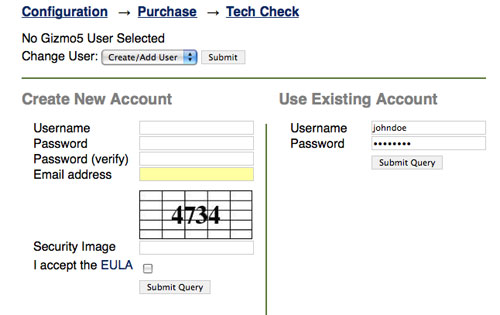
FreePBX Setup for Gizmo5. If you've run the Orgasmatron Installer, you'll have a new Gizmo5 Integration option under the Setup tab. When you click on that option, you have the choice of either creating a new Gizmo5 account or using your existing account. Fill in the blanks to activate or create your new Gizmo5 account.
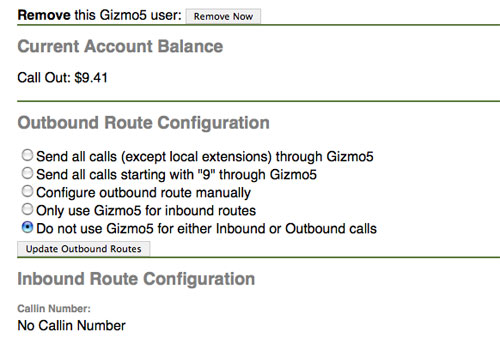
Once you've logged in, click Gizmo5 Integration Main Page. Choose Send all calls (except local extensions) through Gizmo5 and click Update Outbound Routes. For the time being, make certain that you have a default inbound route that rings one or more functioning extensions on your Asterisk system. You have to be able to answer an incoming call to complete the next steps. Finally, click on the Outbound Routes option. In the far right column, move the Gizmo5 entry to the top of the list and reload your dialplan when prompted.
If you're using a FreePBX-based system that doesn't have the Gizmo5 Integration option, you'll first need to establish an account at Gizmo5.com by downloading one of the softphones and signing up. After you have completed the sign up process, be sure that you disable automatic startup of the softphone. You can't have your Asterisk system AND the softphone registering to the same Gizmo5 account!
Next, using FreePBX, Add a new Trunk named Gizmo5. For the Peer Details, insert the following using your actual Gizmo5 phone number and password:
type=peer
insecure=very
host=proxy01.sipphone.com
username=1747XXXXXXX
fromuser=1747XXXXXXX
fromdomain=proxy01.sipphone.com
secret=password
context=from-gizmo5-trunk
qualify=yes
Leave the Incoming Settings section blank and then enter the Registration String using your actual Gizmo5 phone number and password:
1747XXXXXXX:password@proxy01.sipphone.com
Save your settings and reload your dialplan when prompted.
Next, create a Default Inbound Route so that calls from Google Voice will be routed to extensions on your server. Then, create an Outbound Route called OutGizmo with NXXNXXXXXX and 1NXXNXXXXXX as the Dial Patterns and Gizmo5 as the main Trunk Sequence . Move this route to the top of your outbound routes to assure that U.S. calls are placed using the Gizmo5 trunk. Reload your dialplan when prompted.
Finally, log into your Asterisk server as root and insert the following lines at the end of extensions_custom.conf in the /etc/asterisk directory. Then reload the dialplan: asterisk -rx "dialplan reload"
[from-gizmo5-trunk]
exten => s,1,Set(DID_EXTEN=${SIP_HEADER(To):5})
exten => s,n,Set(DID_EXTEN=${CUT(DID_EXTEN,@,1)})
exten => s,n,Goto(from-trunk,${DID_EXTEN},1)
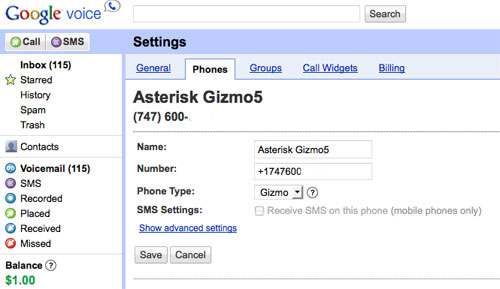
Google Voice Setup. Log into your Google Voice account and click Settings, Phones, Add Another Phone. This forwarding phone number should be the DID that you want Google Voice to call when you have incoming calls on your Google Voice number. Again, to keep things simple, add your Gizmo5 phone number (747XXXXXXX) and select Gizmo as the Phone Type. You then will be prompted to place a test call and provide a 2-digit number to verify that the number is working. Answer the extension on your Asterisk system when it rings and enter the 2-digit code that's provided.
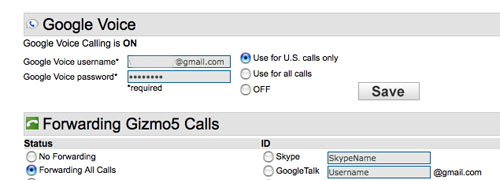
Gizmo5 Configuration. Log in to your Gizmo5 account using your 1747XXXXXXX account number or username and password. In the new Google Voice section of the form, insert your Google Voice email address and password. This is the email address you used to set up your Google Voice account. Choose "Use for U.S. calls only" and then click SAVE.
July 29 Update. Since this article was released, Gizmo5 has reduced the allowable calling time from unlimited to 20 minutes. Then today it was reduced to 3 minutes. That may be as long as you like to talk on the phone, but it's a major change from what was initially introduced 3 short days ago. Looks like we'll dust off our original article after all. Stay tuned...
Deals of the Week. The nation's premier provider of free directory assistance service, 1-800-FREE-411, now is offering free 5-minute phone calls to most destinations around the world. Just listen to two quick commercials and enjoy your free call. Thanks, @MichiganTelephone. And now you can send free SMS messages worldwide from your iPhone. Thanks, @TruVoIP. Finally, AT&T has the refurbished 8GB iPhone 3G for $49 with a two-year contract.
Originally published: July 26, 2009

Need help with Asterisk? Visit the PBX in a Flash Forum.
Or Try the New, Free PBX in a Flash Conference Bridge.
whos.amung.us If you're wondering what your fellow man is reading on Nerd Vittles these days, wonder no more. Visit our new whos.amung.us statistical web site and check out what's happening. It's a terrific resource both for us and for you.
Special Thanks to Our Generous Sponsors
FULL DISCLOSURE: ClearlyIP, Skyetel, Vitelity, DigitalOcean, Vultr, VoIP.ms, 3CX, Sangoma, TelecomsXchange and VitalPBX have provided financial support to Nerd Vittles and our open source projects through advertising, referral revenue, and/or merchandise. As an Amazon Associate and Best Buy Affiliate, we also earn from qualifying purchases. We’ve chosen these providers not the other way around. Our decisions are based upon their corporate reputation and the quality of their offerings and pricing. Our recommendations regarding technology are reached without regard to financial compensation except in situations in which comparable products at comparable pricing are available from multiple sources. In this limited case, we support our sponsors because our sponsors support us.
 BOGO Bonaza: Enjoy state-of-the-art VoIP service with a $10 credit and half-price SIP service on up to $500 of Skyetel trunking with free number porting when you fund your Skyetel account. No limits on number of simultaneous calls. Quadruple data center redundancy. $25 monthly minimum spend required. Tutorial and sign up details are here.
BOGO Bonaza: Enjoy state-of-the-art VoIP service with a $10 credit and half-price SIP service on up to $500 of Skyetel trunking with free number porting when you fund your Skyetel account. No limits on number of simultaneous calls. Quadruple data center redundancy. $25 monthly minimum spend required. Tutorial and sign up details are here.
 The lynchpin of Incredible PBX 2020 and beyond is ClearlyIP components which bring management of FreePBX modules and SIP phone integration to a level never before available with any other Asterisk distribution. And now you can configure and reconfigure your new Incredible PBX phones from the convenience of the Incredible PBX GUI.
The lynchpin of Incredible PBX 2020 and beyond is ClearlyIP components which bring management of FreePBX modules and SIP phone integration to a level never before available with any other Asterisk distribution. And now you can configure and reconfigure your new Incredible PBX phones from the convenience of the Incredible PBX GUI.
 VitalPBX is perhaps the fastest-growing PBX offering based upon Asterisk with an installed presence in more than 100 countries worldwide. VitalPBX has generously provided a customized White Label version of Incredible PBX tailored for use with all Incredible PBX and VitalPBX custom applications. Follow this link for a free test drive!
VitalPBX is perhaps the fastest-growing PBX offering based upon Asterisk with an installed presence in more than 100 countries worldwide. VitalPBX has generously provided a customized White Label version of Incredible PBX tailored for use with all Incredible PBX and VitalPBX custom applications. Follow this link for a free test drive!
 Special Thanks to Vitelity. Vitelity is now Voyant Communications and has halted new registrations for the time being. Our special thanks to Vitelity for their unwavering financial support over many years and to the many Nerd Vittles readers who continue to enjoy the benefits of their service offerings. We will keep everyone posted on further developments.
Special Thanks to Vitelity. Vitelity is now Voyant Communications and has halted new registrations for the time being. Our special thanks to Vitelity for their unwavering financial support over many years and to the many Nerd Vittles readers who continue to enjoy the benefits of their service offerings. We will keep everyone posted on further developments.
Some Recent Nerd Vittles Articles of Interest...
New, Free Hospitality Management System for Asterisk
In another terrific example of open source development at its finest, Claudio Pizzillo has released the beta of his Hospitality Management System for PBX in a Flash systems. Features of the Asterisk® hotel management system include:
- Rooms inventory management with bulk FreePBX extension import
- Call management by prefix with per minute and fixed rates
- Check-In and Check-Out with associated actions
- Billing with search by dates and/or by rooms with call detail
- Integrated with Hotel wake-up module with web interface
- Removal of voicemails and wake-ups on room check-out
Prerequisites. If you're using a PBX in a Flash system, you have all the pieces you'll need to get the Hospitality Management System working. If not, you'll need a LAMP-based Asterisk system with Apache, FreePBX, MySQL, and PHP that's configured to match PBX in a Flash aggregation.
Installation. To install the beta, log into your server as root and issue the following commands:
cd /var/www/html
wget http://www.kefa.it/hotel.tar.gz
tar zxvf hotel.tar.gz
rm hotel.tar.gz
cd hotel
chmod 775 loadmysql.sh
./loadmysql.sh
Next, edit /etc/asterisk/extensions_custom.conf and add the following code at the top of the [from-internal-custom] context. NOTE: This code forces all outbound calls to be routed to the receptionist extension unless the room/extension number is occupied. Make two substitutions below. For MYPBX, replace it with the IP address of your Asterisk server. For RECEPTION, replace it with the extension number for your receptionist's phone.
exten => _X.,1,Set(result=${CURL(http://MYPBX/hotel/checkuser.php?Ext=${CALLERID(num)})})
exten => _X.,2,NoOp(Results: ${result})
exten => _X.,3,GotoIf($["${result}" = "OK"]?OK)
exten => _X.,4,GotoIf($["${result}" = "KO"]?KO)
exten => _X.,5(OK),Goto(outbound-allroutes,${DIAL},1)
exten => _X.,6,Hangup()
exten => _X.,7(KO),DIAL(SIP/RECEPTION)
exten => _X.,8,Hangup()
Remove the line-wrap between the first and second lines. Then save your changes to the file and reload your dialplan: asterisk -rx "dialplan reload"
Using the Hotel Management System. To use the application, use a web browser pointed to the actual IP address of your server: http://serverIP/hotel/. The web interface is self-explanatory. If you need additional assistance, post your questions and suggestions on the PBX in a Flash Forum. Enjoy!
Twitter Deals of the Week. The nation's premier provider of free directory assistance service, 1-800-FREE-411, now is offering free 5-minute phone calls to most destinations around the world. Just listen to two quick commercials and enjoy your free call. Thanks, @MichiganTelephone. And now you can send free SMS messages worldwide from your iPhone. Thanks, @TruVoIP.

Need help with Asterisk? Visit the PBX in a Flash Forum.
Or Try the New, Free PBX in a Flash Conference Bridge.
whos.amung.us If you're wondering what your fellow man is reading on Nerd Vittles these days, wonder no more. Visit our new whos.amung.us statistical web site and check out what's happening. It's a terrific resource both for us and for you.
Special Thanks to Our Generous Sponsors
FULL DISCLOSURE: ClearlyIP, Skyetel, Vitelity, DigitalOcean, Vultr, VoIP.ms, 3CX, Sangoma, TelecomsXchange and VitalPBX have provided financial support to Nerd Vittles and our open source projects through advertising, referral revenue, and/or merchandise. As an Amazon Associate and Best Buy Affiliate, we also earn from qualifying purchases. We’ve chosen these providers not the other way around. Our decisions are based upon their corporate reputation and the quality of their offerings and pricing. Our recommendations regarding technology are reached without regard to financial compensation except in situations in which comparable products at comparable pricing are available from multiple sources. In this limited case, we support our sponsors because our sponsors support us.
 BOGO Bonaza: Enjoy state-of-the-art VoIP service with a $10 credit and half-price SIP service on up to $500 of Skyetel trunking with free number porting when you fund your Skyetel account. No limits on number of simultaneous calls. Quadruple data center redundancy. $25 monthly minimum spend required. Tutorial and sign up details are here.
BOGO Bonaza: Enjoy state-of-the-art VoIP service with a $10 credit and half-price SIP service on up to $500 of Skyetel trunking with free number porting when you fund your Skyetel account. No limits on number of simultaneous calls. Quadruple data center redundancy. $25 monthly minimum spend required. Tutorial and sign up details are here.
 The lynchpin of Incredible PBX 2020 and beyond is ClearlyIP components which bring management of FreePBX modules and SIP phone integration to a level never before available with any other Asterisk distribution. And now you can configure and reconfigure your new Incredible PBX phones from the convenience of the Incredible PBX GUI.
The lynchpin of Incredible PBX 2020 and beyond is ClearlyIP components which bring management of FreePBX modules and SIP phone integration to a level never before available with any other Asterisk distribution. And now you can configure and reconfigure your new Incredible PBX phones from the convenience of the Incredible PBX GUI.
 VitalPBX is perhaps the fastest-growing PBX offering based upon Asterisk with an installed presence in more than 100 countries worldwide. VitalPBX has generously provided a customized White Label version of Incredible PBX tailored for use with all Incredible PBX and VitalPBX custom applications. Follow this link for a free test drive!
VitalPBX is perhaps the fastest-growing PBX offering based upon Asterisk with an installed presence in more than 100 countries worldwide. VitalPBX has generously provided a customized White Label version of Incredible PBX tailored for use with all Incredible PBX and VitalPBX custom applications. Follow this link for a free test drive!
 Special Thanks to Vitelity. Vitelity is now Voyant Communications and has halted new registrations for the time being. Our special thanks to Vitelity for their unwavering financial support over many years and to the many Nerd Vittles readers who continue to enjoy the benefits of their service offerings. We will keep everyone posted on further developments.
Special Thanks to Vitelity. Vitelity is now Voyant Communications and has halted new registrations for the time being. Our special thanks to Vitelity for their unwavering financial support over many years and to the many Nerd Vittles readers who continue to enjoy the benefits of their service offerings. We will keep everyone posted on further developments.
Some Recent Nerd Vittles Articles of Interest...
Some Summertime Distractions for Asterisk Lovers

In addition to Spoleto and the Bridge Run, Charleston has many great traditions, one of which is a prompt transition from a rainy, cold winter into sweltering summer. We got a very long spring break this year, but now we’re paying for it. After spending a couple weeks on Balsam Mountain, it was nothing short of culture shock driving back into Charleston last night. But we’re glad to be home. And this week, we celebrate summer with a list of some of our favorite vacation discoveries that didn’t involve snakes and bears. Some are related to Asterisk®, and some aren’t. So here goes.
 Streaming Video with Roku. If you haven’t figured out why Time Warner and Comcast have been pushing for Internet bandwidth caps, here’s a hint. Streaming video not only is killing their pipes, but more importantly (to them) it’s killing their pay-per-view and HBO/Showtime monopolies. If you enjoy (or can even remember) great television and movies without thousands of commercials, then we’ve got two discoveries that will make your summer! The first one is Roku, a little $100 device about the size and weight of a couple packs of cigarettes. You plug it into your TV and the Internet, pop the popcorn, and you’re ready for some fun. With an $8.95 Netflix subscription (which buys you one-at-a-time DVD rentals by mail), you also get unlimited movies streamed to your Roku device. It’s not their entire catalog, but it’s a substantial subset including most of the Starz catalog. The Roku player supports composite, S-video, component, and HDMI video connections as well as stereo and optical audio. A new addition allows the rental or purchase of first-run movies from Amazon (at Blockbuster prices). More offerings are promised for later this summer. Can Hulu be far behind? If you’ve been holding off purchasing a Blu-Ray player, then here’s another option. LG’s new $200 BD370 Blu-Ray Disc Player incorporates this same technology in addition to YouTube access. We haven’t used the BD370 yet, but we sure do want one.
Streaming Video with Roku. If you haven’t figured out why Time Warner and Comcast have been pushing for Internet bandwidth caps, here’s a hint. Streaming video not only is killing their pipes, but more importantly (to them) it’s killing their pay-per-view and HBO/Showtime monopolies. If you enjoy (or can even remember) great television and movies without thousands of commercials, then we’ve got two discoveries that will make your summer! The first one is Roku, a little $100 device about the size and weight of a couple packs of cigarettes. You plug it into your TV and the Internet, pop the popcorn, and you’re ready for some fun. With an $8.95 Netflix subscription (which buys you one-at-a-time DVD rentals by mail), you also get unlimited movies streamed to your Roku device. It’s not their entire catalog, but it’s a substantial subset including most of the Starz catalog. The Roku player supports composite, S-video, component, and HDMI video connections as well as stereo and optical audio. A new addition allows the rental or purchase of first-run movies from Amazon (at Blockbuster prices). More offerings are promised for later this summer. Can Hulu be far behind? If you’ve been holding off purchasing a Blu-Ray player, then here’s another option. LG’s new $200 BD370 Blu-Ray Disc Player incorporates this same technology in addition to YouTube access. We haven’t used the BD370 yet, but we sure do want one.
 Cellphones for Preteens. We laughed at our friends from Naples, Florida last summer when they were lamenting the fact that every child in their daughter’s second grade class had a cellphone except for theirs. They swore that they wouldn’t give in. That lasted until Christmas when the shiny new LG Xenon appeared. Chuckling all the way to spring, we recently met the same fate with the Samsung A767 Propel after our 9-year-old raised over $300 selling all of her old toys at the neighborhood yard sale. Bottom line: All the kids are going to have them by the time they turn 10. And with the family plans available from a number of providers, the costs are no longer prohibitive for most of us. You might as well get them trained to use cellphones responsibly while they’re young. Trust me. It’s a lot more difficult once they hit high school or college and know everything. There is a difference between adult and kid usage of cellphones. They rarely make a call. But you’ll want an unlimited texting plan. And none of the kids want an iPhone. They much prefer one the newer phones that includes a full keyboard for texting. Apple, are you listening?
Cellphones for Preteens. We laughed at our friends from Naples, Florida last summer when they were lamenting the fact that every child in their daughter’s second grade class had a cellphone except for theirs. They swore that they wouldn’t give in. That lasted until Christmas when the shiny new LG Xenon appeared. Chuckling all the way to spring, we recently met the same fate with the Samsung A767 Propel after our 9-year-old raised over $300 selling all of her old toys at the neighborhood yard sale. Bottom line: All the kids are going to have them by the time they turn 10. And with the family plans available from a number of providers, the costs are no longer prohibitive for most of us. You might as well get them trained to use cellphones responsibly while they’re young. Trust me. It’s a lot more difficult once they hit high school or college and know everything. There is a difference between adult and kid usage of cellphones. They rarely make a call. But you’ll want an unlimited texting plan. And none of the kids want an iPhone. They much prefer one the newer phones that includes a full keyboard for texting. Apple, are you listening?
If you go down this road with the rest of us that swore we wouldn’t do it, demand two things: (1) that your kids not use cellphones while driving and (2) that they not hold cellphones up to their ears while making calls. The jury is still out on whether cellphone usage leads to brain tumors. But it seems pretty obvious when you review the research provided by organizations not funded by the cellphone industry. Remember the tobacco companies swore that cigarettes were safe for decades, and they paid good money for authoritative-sounding research to back them up. Read this. And watch this. Then decide whether you want to gamble with the lives of your children. Better safe than sorry.
Deals, Deals, and More Deals. If you always shop for technology purchases at the same few stores, then send us a check for all the money we’re about to save you. There’s a green eBates coupon in the right pane just below that will usually save you 1-5% on all your technology and clothing purchases and just about anything else. It costs nothing to use it, and you’ll get $5 just for signing up. So do we. 🙂 To go with those savings, there are some bargain web sites that you won’t want to miss. Our old favorite is TechBargains, but there’s also a new kid on the block, DealNews. Check ’em out. You’ll find something you just can’t live without… at bargain basement prices.
 SMS Messaging with Asterisk. We’ve always lamented the fact that Asterisk had no built in SMS messaging capability. This is primarily because the cellphone providers keep a fairly tight lock on the SMS business since it’s their Cash Cow. There is a simple solution actually.
SMS Messaging with Asterisk. We’ve always lamented the fact that Asterisk had no built in SMS messaging capability. This is primarily because the cellphone providers keep a fairly tight lock on the SMS business since it’s their Cash Cow. There is a simple solution actually.
Virtually all of the cellphone providers have an Email-to-SMS gateway that can be used for sending SMS messages to their customers. For example, to send a message to a cellphone subscriber on the AT&T network, you just send an email message to 6781234567@txt.att.net. Click here for a complete list of the email gateway addresses.
That got us to thinking how simple it really would be to create a bash script that delivered the same message to every provider used by your friends. Who cares if all but one of the messages goes in the bit bucket. Your SMS message still will get delivered. For example, in the United States, if you’ve covered AT&T, Verizon, Alltel, Sprint, T-Mobile, US Cellular, Cricket, and Nextel, that pretty much gets 99% of the cellphones. If there’s a service that we’ve left out that you really need, just add another line to the bash script with the domain of that carrier.
So, log into your server as root and create a bash script named sms.sh that looks like the following: nano -w sms.sh
#!/bin/bash
# Script for sending SMS messages
# For additional cell carriers, see:
# http://en.wikipedia.org/wiki/List_of_carriers_providing_Email_or_Web_to_SMSmsg="Just testing the new SMS batch script."
subj="SMS Message"
num2call="8431234567″echo "$msg" | mail -s "$subj" $num2call@message.alltel.com
echo "$msg" | mail -s "$subj" $num2call@txt.att.net
echo "$msg" | mail -s "$subj" $num2call@sms.mycricket.com
echo "$msg" | mail -s "$subj" $num2call@messaging.nextel.com
echo "$msg" | mail -s "$subj" $num2call@messaging.sprintpcs.com
echo "$msg" | mail -s "$subj" $num2call@tmomail.net
echo "$msg" | mail -s "$subj" $num2call@email.uscc.net
echo "$msg" | mail -s "$subj" $num2call@vtext.com
Fill in the msg, subj, and num2call fields. Press Ctl-X, Y, then Enter to save your file. Then make it executable: chmod +x sms.sh. Now give it a try: ./sms.sh
You can alter the sender address for your emails from the default of root by inserting an entry like the following in /etc/mail/genericstable: root joeschmo@gmail.com. Then restart SendMail: service sendmail restart.
Micro$oft Bing. I have to admit that I’ve always had a soft spot for Microsoft. They came from humble beginnings and outsmarted almost everybody during the 80’s and 90’s… until Google entered the picture and did much the same thing to them. You’ve also got to hand it to Microsoft. They may not get it right the first, or second, or third time. But they don’t give up. And their reincarnated search engine, Bing, is worth a look. It includes an Explorer Pane that categorizes search results in a left panel that is customized to your search query. There’s also a Quick Preview providing website popups. The theory is to give you a sneak peak at a particular site to see if it’s what you’re looking for. As with many Microsoft creations, it’s just too slow at the moment to be of much value. Good idea. Not so good implementation.
A good bit already has been written about Bing’s picture and video search capabilities. Suffice it to say, once they tamed the content, it’s worth a look. Actually, it was worth a look even before they tamed the content. 🙂 But give Microsoft credit, they quickly recognized that there needs to be a way to make the web accessible to younger children and students without exposing them to an endless stream of pornography. What happened to the good old days of reading National Geographic to find all that stuff?
Microsoft’s Farecast technology also is interesting. It brings new, smart tools to the process of purchasing airline and hotel accommodations. Much of this toolkit was acquired by Microsoft, but it’s pretty slick. The downside of Bing, when compared to Google, is that there seems to be a tilt toward Microsoft content in results. And there still is a lot of drill-down (aka Windows) to find exactly what you’re looking for. Both are deeply rooted in the Microsoft psyche so I doubt it’ll ever go away. But have a look anyway. It’s an interesting, new product to at least have in your search toolkit.
Let There Be Music. All-you-can-eat streaming music plans have been around for a while. But there’s never been anything quite like the new Napster service from Best Buy. $5 a month for access to 7 million songs on either your PC or a Sonos sound system is just too good to pass up. We’ve previously written about this so we won’t repeat it all here. Have a look at the article if you’re a music addict. And, if streaming DRM’d music isn’t your thing, check out this PC Mag article on Virgin Media’s new offering. It will let you download an unlimited number of MP3’s from Universal’s entire music catalog for about $20 a month. Unbelievable!
People Tracking. If you glance over to the right margin, you’ll get a good sample of Google’s Latitude offering that pinpoints your location on a Google map using GPS data from your cellphone. AT&T offers something similar for "only" $10-$15 a month. This data can be either the location of the nearest cellphone tower or, if your phone is GPS-enabled, it can be the actual GPS coordinates of your phone. There are obviously privacy issues that need to be weighed, and Google has carefully addressed most of those issues. You can restrict access to select friends, or just family, or no one at all. In coming months, we’re going to build something similar with Google Maps to display a map with the default location of incoming calls on certain color SIP phones. Stay tuned. In the meantime, feel free to monitor our summer vacation as we move from Charleston, to the beach, and back to the mountains. Not too exciting, but it may give you some ideas for future uses of this technology. For those of you with young daughters, think of it as LoJack for Parents!
Footnote: Uh, oh. Google.everything just died. 8:30 a.m., June 16. Bad way to start your day. Good time to check out Bing. 🙂

Hurricane Tracking. If hurricanes are a part of your everyday life and you haven’t visited Stormpulse.com yet, you’re missing the ultimate storm tracking site on the net. Not only do they provide up-to-the-minute predictions from all of the world’s best sources, but you also get map overlays showing virtually anything you’d ever want to know that’s weather-related. Unbelievably good! And, for a ringside seat, visit our own Pawleys Island WebCam. We’ll wave to you later this week.
Promising New Asterisk Appliance. Every now and then we read an article about a new Asterisk appliance that really shows some promise. So it is with Michael Graves’ recent writeup of Jazinga, a $1095 Asterisk appliance that does just about anything and everything a small business would ever need in a phone system using a simple but intuitive web interface. Have a look. We think you’ll agree. Very slick, indeed. Only wish it were $595 instead of $1095.
Some Great Blogs. And, speaking of blogs, there are some other telephony blogs in addition to Graves on SOHO VoIP that are worth a look from time to time. Here’s another Baker’s Dozen of our favorites in no particular order:
- Asterisk.org Blog
- FierceVoIP
- truVoIPbuzz
- Smith On VoIP
- Asterisk Guru
- Scobleizer
- VoIP Watch
- GigaOM
- Tom Keating
- Alec Saunders
- Leif Madsen
- Smith on VoIP
- Michigan Telephone Blog
FreeNum Dialing System. Another new project worth a careful look is FreeNum. Taking a page from Nextel, FreeNum lets you make SIP calls from ordinary telephones after registering your organization. The format of a FreeNum dial string looks like 1234*567 where your extension is 1234 and your ITAD (Internet Telephony Administrative Domain) number is 567. FreeNUM relies upon DNS and, as such, is perfectly suited for transparent use over the Internet. In coming weeks, we’ll have more to say about FreeNUM including a methodology for letting all PBX in a Flash systems register with a shared ITAD for transparent communications worldwide. Here’s the article.
Twitter. The entire planet is aflutter with Twitter. We finally bit the bullet, and we’d be the first to admit that Twitter fills an important gap in today’s Internet-centric 21st century world. Not only does it provide instantaneous searches of very current content, it’s also quite useful as a micro-blogging tool if you like to keep current on technology happenings without always waiting for full-blown articles to appear. Many of the topics in this article were first introduced to Twitter users over the last few weeks. So there’s much more to Twitter than periodic reports of individuals’ bathroom and sleeping habits. You can get a sampling by reviewing our Twitter entries in the right pane of this blog. And there are literally hundreds of Twitter clients to meet your every need. Here’s a link to a great Twitter FAQ. Then give Twitter a try if you haven’t already. NerdUno is looking forward to hearing from you.
Wordle.net. We’ve mentioned Wordle before, but no article on Internet fun would be complete without at least a passing reference. The way Wordle works is that you pass it some text. It then rearranges the words in a hierarchical order that exposes the word usage count of the various words in the text it examined. You can see an example below which took the subject matter from the PBX in a Flash Help Forum and passed it through Wordle. You’ll note that "Resolved" is just about the same size as "problem" and "question." That actually speaks volumes about the quality of our forum. Give it a try. We think you’ll agree. We’ve done some other samples to give you some ideas: the Gettysburg Address, the Declaration of Independence, and MLK’s I Have A Dream speech. Try a few of your own. It’s a summertime blast. Enjoy!

Need help with Asterisk? Visit the PBX in a Flash Forum.
Or Try the New, Free PBX in a Flash Conference Bridge.
whos.amung.us If you’re wondering what your fellow man is reading on Nerd Vittles these days, wonder no more. Visit our new whos.amung.us statistical web site and check out what’s happening. It’s a terrific resource both for us and for you.
Special Thanks to Our Generous Sponsors
FULL DISCLOSURE: ClearlyIP, Skyetel, Vitelity, DigitalOcean, Vultr, VoIP.ms, 3CX, Sangoma, TelecomsXchange and VitalPBX have provided financial support to Nerd Vittles and our open source projects through advertising, referral revenue, and/or merchandise. As an Amazon Associate and Best Buy Affiliate, we also earn from qualifying purchases. We’ve chosen these providers not the other way around. Our decisions are based upon their corporate reputation and the quality of their offerings and pricing. Our recommendations regarding technology are reached without regard to financial compensation except in situations in which comparable products at comparable pricing are available from multiple sources. In this limited case, we support our sponsors because our sponsors support us.
 BOGO Bonaza: Enjoy state-of-the-art VoIP service with a $10 credit and half-price SIP service on up to $500 of Skyetel trunking with free number porting when you fund your Skyetel account. No limits on number of simultaneous calls. Quadruple data center redundancy. $25 monthly minimum spend required. Tutorial and sign up details are here.
BOGO Bonaza: Enjoy state-of-the-art VoIP service with a $10 credit and half-price SIP service on up to $500 of Skyetel trunking with free number porting when you fund your Skyetel account. No limits on number of simultaneous calls. Quadruple data center redundancy. $25 monthly minimum spend required. Tutorial and sign up details are here.
 The lynchpin of Incredible PBX 2020 and beyond is ClearlyIP components which bring management of FreePBX modules and SIP phone integration to a level never before available with any other Asterisk distribution. And now you can configure and reconfigure your new Incredible PBX phones from the convenience of the Incredible PBX GUI.
The lynchpin of Incredible PBX 2020 and beyond is ClearlyIP components which bring management of FreePBX modules and SIP phone integration to a level never before available with any other Asterisk distribution. And now you can configure and reconfigure your new Incredible PBX phones from the convenience of the Incredible PBX GUI.
 VitalPBX is perhaps the fastest-growing PBX offering based upon Asterisk with an installed presence in more than 100 countries worldwide. VitalPBX has generously provided a customized White Label version of Incredible PBX tailored for use with all Incredible PBX and VitalPBX custom applications. Follow this link for a free test drive!
VitalPBX is perhaps the fastest-growing PBX offering based upon Asterisk with an installed presence in more than 100 countries worldwide. VitalPBX has generously provided a customized White Label version of Incredible PBX tailored for use with all Incredible PBX and VitalPBX custom applications. Follow this link for a free test drive!
 Special Thanks to Vitelity. Vitelity is now Voyant Communications and has halted new registrations for the time being. Our special thanks to Vitelity for their unwavering financial support over many years and to the many Nerd Vittles readers who continue to enjoy the benefits of their service offerings. We will keep everyone posted on further developments.
Special Thanks to Vitelity. Vitelity is now Voyant Communications and has halted new registrations for the time being. Our special thanks to Vitelity for their unwavering financial support over many years and to the many Nerd Vittles readers who continue to enjoy the benefits of their service offerings. We will keep everyone posted on further developments.
Some Recent Nerd Vittles Articles of Interest…
Asterisk TTS: Introducing Today in History
 If you're a history buff and want a convenient way to find out everything that ever happened Today in History, then this week's text to speech (TTS) application for Asterisk® should be just what you need. Pick up any phone connected to your Asterisk system and dial T-O-D-A-Y (86329 for the spelling-impaired). The script will retrieve today's historical events and today's birthdays of interest from Yahoo News and play the results back to you over the phone using either Flite or Cepstral to handle the TTS translation. To speed up the retrieval process, you can also set this up as a cron job to download the latest events each day while you're sleeping. Thereafter, when you dial T-O-D-A-Y, the results are played back for callers instantaneously.
If you're a history buff and want a convenient way to find out everything that ever happened Today in History, then this week's text to speech (TTS) application for Asterisk® should be just what you need. Pick up any phone connected to your Asterisk system and dial T-O-D-A-Y (86329 for the spelling-impaired). The script will retrieve today's historical events and today's birthdays of interest from Yahoo News and play the results back to you over the phone using either Flite or Cepstral to handle the TTS translation. To speed up the retrieval process, you can also set this up as a cron job to download the latest events each day while you're sleeping. Thereafter, when you dial T-O-D-A-Y, the results are played back for callers instantaneously.
Prerequisites. If you're using PBX in a Flash, then all of the tools you'll need are already in place. And we have a script for you that will install the application in just a few seconds. For other users, you'll need an Asterisk server with PHP5 and either Flite or Cepstral to handle the text-to-speech chores.
Overview. If you've previously installed other Nerd Vittles text to speech applications, then the drill this time around is quite similar. There's a PHP/AGI script which gets stored in /var/lib/asterisk/agi-bin. In this script (nv-today.php), you can change the default Flite TTS engine to Cepstral by changing the $ttspick variable setting from 0 to 1. Then there is a snippet of dialplan code that needs to be added to the [from-internal-custom] context in extensions_custom.conf for FreePBX installations. Once you reload your Asterisk dialplan, you're ready to go.
How It Works. The PHP/AGI script only does real work once a day. It always checks to see if there is an existing /tmp/today.txt file with today's file stamp. If there is, it exits gracefully. If today's file doesn't exist or if the file's time stamp is earlier than midnight, then the script downloads the latest information for today in history and creates a text file of the data. Then either the Flite or Cepstral TTS engine is called to convert the text file into /tmp/today.wav. The dial plan code is used to answer calls to extension 86329. Then it runs the PHP/AGI script, and finally it plays back /tmp/today.wav. Note: The PHP/AGI script, if run as a cron job or from the command prompt, should never be run as the root user, but only as the asterisk user. Otherwise, the today.txt and today.wav files cannot be replaced by the script when it subsequently is run from the dialplan.
Script Installation. If you're using PBX in a Flash, log into your server as root and issue the following commands:
cd /root
wget http://bestof.nerdvittles.com/applications/today/today.pbx
chmod +x today.pbx
./today.pbx
Automatic Updates Using crontab. If you'd like to automatically generate the Today in History files each day, add the following entry to the bottom of /etc/crontab:
01 0 * * * asterisk /var/lib/asterisk/agi-bin/nv-today.php
Manual Installation. For those using a different Asterisk aggregation that includes PHP5, FreePBX, and Flite, add this code to /etc/asterisk/extensions_custom.conf in the [from-internal-custom] context:
exten => 86329,1,Answer
exten => 86329,2,Wait(1)
exten => 86329,3,Set(TIMEOUT(digit)=7)
exten => 86329,4,Set(TIMEOUT(response)=10)
exten => 86329,5,Flite(Please stand bye while we retrieve: Today in History.)
exten => 86329,6,AGI(nv-today.php)
exten => 86329,7,Playback(/tmp/today)
exten => 86329,8,Wait(1)
exten => 86329,9,Hangup
Then issue the following commands from the command prompt after logging in as root:
cd /root
mkdir today
cd today
wget http://bestof.nerdvittles.com/applications/today/today.zip
unzip today.zip
rm -f today.zip
cp nv-today.php /var/lib/asterisk/agi-bin/nv-today.php
chmod 775 /var/lib/asterisk/agi-bin/nv-today.php
chown asterisk:asterisk /var/lib/asterisk/agi-bin/nv-today.php
asterisk -rx "dialplan reload"
Running the Application. Now you're ready for a test run. Pick up any phone connected to your Asterisk system and dial T-O-D-A-Y. After a brief pause to download the data, today's events in history and today's birthdays will be played back over your phone using your favorite text to speech voice. To eliminate the pause the first time the application is run each day, simply add the crontab entry as outlined above. Enjoy!

Free DIDs While They Last. Sipgate is giving away a free U.S. DID with free incoming calls plus 200 free minutes for outbound calls. Better hurry. Here's the trunk setup for FreePBX-based systems:
Trunk name: sipgate
type=peer
username=ACCTNO
fromuser=ACCTNO
secret=ACCTPW
context=from-trunk
host=sipgate.com
fromdomain=sipgate.com
insecure=very
caninvite=no
canreinvite=no
nat=no
disallow=all
allow=ulaw&alawRegistration Strong: ACCTNO:ACCTPW@sipgate.com/YOUR-DID-NUMBER
ACCTNO is the account number assigned to your sipgate account. ACCTPW is the password for your account. YOUR-DID-NUMBER is your 10-digit DID.
Finally create an inbound route using your actual 10-digit DID and assign a destination for the inbound calls.

Need help with Asterisk? Visit the PBX in a Flash Forum.
Or Try the New, Free PBX in a Flash Conference Bridge.
Twitter Magic. If you haven't noticed the right margin of Nerd Vittles lately, we've added a new link to our Twitter feed. If you explore a little, you'll discover that the user interface now brings you instant access to every Twitter feed from the convenience of the Nerd Vittles desktop. Enjoy!
whos.amung.us If you're wondering what your fellow man is reading on Nerd Vittles these days, wonder no more. Visit our new whos.amung.us statistical web site and check out what's happening. It's a terrific resource both for us and for you.
Special Thanks to Our Generous Sponsors
FULL DISCLOSURE: ClearlyIP, Skyetel, Vitelity, DigitalOcean, Vultr, VoIP.ms, 3CX, Sangoma, TelecomsXchange and VitalPBX have provided financial support to Nerd Vittles and our open source projects through advertising, referral revenue, and/or merchandise. As an Amazon Associate and Best Buy Affiliate, we also earn from qualifying purchases. We’ve chosen these providers not the other way around. Our decisions are based upon their corporate reputation and the quality of their offerings and pricing. Our recommendations regarding technology are reached without regard to financial compensation except in situations in which comparable products at comparable pricing are available from multiple sources. In this limited case, we support our sponsors because our sponsors support us.
 BOGO Bonaza: Enjoy state-of-the-art VoIP service with a $10 credit and half-price SIP service on up to $500 of Skyetel trunking with free number porting when you fund your Skyetel account. No limits on number of simultaneous calls. Quadruple data center redundancy. $25 monthly minimum spend required. Tutorial and sign up details are here.
BOGO Bonaza: Enjoy state-of-the-art VoIP service with a $10 credit and half-price SIP service on up to $500 of Skyetel trunking with free number porting when you fund your Skyetel account. No limits on number of simultaneous calls. Quadruple data center redundancy. $25 monthly minimum spend required. Tutorial and sign up details are here.
 The lynchpin of Incredible PBX 2020 and beyond is ClearlyIP components which bring management of FreePBX modules and SIP phone integration to a level never before available with any other Asterisk distribution. And now you can configure and reconfigure your new Incredible PBX phones from the convenience of the Incredible PBX GUI.
The lynchpin of Incredible PBX 2020 and beyond is ClearlyIP components which bring management of FreePBX modules and SIP phone integration to a level never before available with any other Asterisk distribution. And now you can configure and reconfigure your new Incredible PBX phones from the convenience of the Incredible PBX GUI.
 VitalPBX is perhaps the fastest-growing PBX offering based upon Asterisk with an installed presence in more than 100 countries worldwide. VitalPBX has generously provided a customized White Label version of Incredible PBX tailored for use with all Incredible PBX and VitalPBX custom applications. Follow this link for a free test drive!
VitalPBX is perhaps the fastest-growing PBX offering based upon Asterisk with an installed presence in more than 100 countries worldwide. VitalPBX has generously provided a customized White Label version of Incredible PBX tailored for use with all Incredible PBX and VitalPBX custom applications. Follow this link for a free test drive!
 Special Thanks to Vitelity. Vitelity is now Voyant Communications and has halted new registrations for the time being. Our special thanks to Vitelity for their unwavering financial support over many years and to the many Nerd Vittles readers who continue to enjoy the benefits of their service offerings. We will keep everyone posted on further developments.
Special Thanks to Vitelity. Vitelity is now Voyant Communications and has halted new registrations for the time being. Our special thanks to Vitelity for their unwavering financial support over many years and to the many Nerd Vittles readers who continue to enjoy the benefits of their service offerings. We will keep everyone posted on further developments.
Some Recent Nerd Vittles Articles of Interest...
VoIP Over VPN: Securely Interconnecting Asterisk Servers
We’ve just returned from a week in the Pacific Northwest teaching an Asterisk® course for an organization that wants to interconnect satellite offices using Asterisk servers. This coincided with a support request from one of America’s premier airlines which wants to do much the same thing for all of its reservation counters in airports situated in feeder cities around the country. Suffice it to say, PBX in a Flash in conjunction with Asterisk and Hamachi VPNs is perfectly suited to let anyone build these interconnected systems in minutes rather than months. In fact, with less than a day’s worth of introduction to Asterisk and PBX in a Flash, a group of 16 network administrators with no previous Asterisk experience did just that in a one-hour lab session during our training seminar last week. At the risk of (further) destroying our ability to earn a living, here’s how we did it.
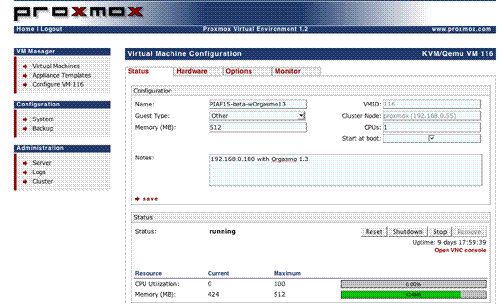
Proxmox as a Training Tool. Before we get into the nitty gritty of actually interconnecting Asterisk servers with Hamachi VPNs, let us provide the free tip of the week for those of you that want to experiment with interconnecting Asterisk servers or for those that like to test various Asterisk scenarios without rebuilding servers all day long. There is no finer tool for this than the Proxmox Virtual Environment, a free and easy to use Open Source virtualization platform for running Virtual Appliances and Virtual Machines. With a sale-priced Dell T105 with a Quad Core AMD Opteron processor and 8 gigs of RAM, you’ll have a perfect platform to run about 16 simultaneous PBX in a Flash servers. The trick is finding the machines on sale for half price which is about every other week. Our lab system which matches this configuration was less than $600 with RAM purchased from a third party. You can save most of the shipping cost by using our coupon link in the right column to shop at Dell’s small business site.
Proxmox lets you build virtual machines in two ways: OpenVZ templates or Qemu/KVM Templates and ISO images. While we intend to offer an OpenVZ template for PBX in a Flash soon, currently it’s easy to create your own ISO template using the standard PBX in a Flash ISO image. Once you’ve uploaded your ISO image into Proxmox, simply create a new virtual machine by giving it a name, specifying 512MB of RAM and a 30GB partition. In 10 seconds or less, your new VM will be ready to boot. Start your VM and then open the VNC console window within the Proxmox web interface and install PBX in a Flash just as if you were building a stand-alone machine. When the 15-minute install completes, run through the Orgasmatron Installer setup, and you’ll have your turnkey PBX in a Flash system ready for production in less than 30 minutes.
You don’t have to repeat this drill for every virtual machine. Instead, use the built-in Proxmox backup utility to make a backup image of what you built. Shut down the VM, create a /backup directory, and then schedule the compressed backup in the web browser. When the backup completes, you’ll have a backup image in /backup with a file name like this: vzdump-101.tgz.
To create a new virtual machine, you issue the following command while positioned in the /backup directory specifying the number for the new virtual machine:
vzdump --restore vzdump-101.tgz 102
In about 3 minutes, you’ll have a second virtual machine that’s a clone of the first one. Because it’s a true clone, it would obviously have the same MAC address for the virtual NIC. You don’t want that or all of your VMs would boot up using the same IP address. Using the Proxmox web interface, just edit the new VM 102 by switching from the Status tab to the Hardware tab, delete the existing Ethernet device, and then create a new Ethernet device under the hardware address list pulldown. This will create a new virtual NIC with a new MAC address. So, when you boot VM 102, it will be assigned a new IP address by your DHCP server. You can decipher the new IP address by opening the VNC console window for VM 102 after you boot it up. Now you’re an expert. You can create the additional Baker’s Dozen turnkey PBX in a Flash servers in about an hour. Start all of them up, and you’ve got an instant training facility and PBX in a Flash playground.
April, 2012 Update. See our new article for a current state-of-the-art VoIP VPN.
Creating Hamachi VPN. You obviously don’t need a virtual private network in order to interconnect Asterisk servers. But, as easy as the Hamachi VPN is to set up, especially with PBX in a Flash servers, why wouldn’t you want all of your inter-Asterisk communications secured and encrypted? In addition to the capacity limitation of the Proxmox server, there’s another reason we chose to build 16 PBX in a Flash VMs. That happens to be the number of servers you can interconnect with the Hamachi Virtual Private Network without incurring a charge.1 Why use the Hamachi VPN when OpenVPN is free with unlimited network connections and no strings? The short answer is it’s incredibly simple to set up without public and private key hassles, and it supports dynamic IP server addressing with zero configuration. We plan to cover OpenVPN in a subsequent article but, for many implementations, Hamachi VPNs offer a robust, flexible alternative that can be deployed in minutes.
If you’re not using PBX in a Flash, there are a million good Hamachi VPN tutorials available through a quick Google search. If you are using PBX in a Flash, we’ve done the work for you. With the Orgasmatron Installer build, you’ll find the Hamachi VPN installation script in /root/nv. For other PBX in a Flash systems, just download the install-hamachi.x script from here or, after logging into your server as root, issue the following commands:
wget http://pbxinaflash.net/source/hamachi/install-hamachi.x
chmod +x install-hamachi.x
./install-hamachi.x
Before beginning the Hamachi VPN install, it’s a good idea to make yourself a cheat sheet for the servers you plan to interconnect. We’re going to interconnect 3 servers today, but doing 16 is just more of the same. You’ll need a unique name for your virtual private network. Pick a name that distinguishes this VPN from others you may build down the road. For our example, we’re going to use piaf-vpn. Next, you need a very secure password for your VPN. We’re going to use password for demonstration purposes only. Finally, you need a unique nickname for each of your servers, e.g. piaf-server1, piaf-server2, and piaf-server3 for our example setup today.
For the first Hamachi install, we’ll need to create the new network. For the remaining installs, we’ll simply join the existing network. Keep in mind that you can only remove machines from the network using the same server that was used to create the other VPN accounts initially so build out your virtual private network by starting with your main server, piaf-server1 in our example.
To begin the Hamachi VPN install, run the script using the commands shown above. Type Y to agree to the installer license and then press the Enter key to kick off the install. For the piaf-server1 install, type N to create a new Hamachi network. For the remaining installs, you’d type J to join an existing Hamachi network. Enter the network name you chose above. For our sample, we used piaf-vpn. Type it twice when prompted. Now type your network password and then your nickname for this server when prompted to do so. Then standby while the Hamachi software is installed. It takes a few minutes depending upon the speed of your network connection. And remember, do NOT use our sample network name. Make up your own and don’t forget it. When the install completes, you can review the log if you’d like. Unless something has come unglued, Hamachi should now be running on your first server. Repeat the drill on your other servers.
The next step is to grab some of our scripts to make it easier to manage Hamachi on your servers.
cd /usr/local/bin
wget http://pbxinaflash.net/source/hamachi/hampiaf
wget http://pbxinaflash.net/source/hamachi/hamachi-servers
chmod +x ham*
cd /root
wget http://pbxinaflash.net/source/hamachi/hamachi.faq
The hamachi.faq document provides all of the commands you’ll need to manage Hamachi including the steps to start over with a totally new virtual private network. For now, let’s be sure your network is running. Type: hamachi-servers piaf-vpn using the network name you assigned to your own VPN. Then type it again, and it should display all of the servers on your VPN with their private VPN IP addresses:
root@pbx:~ $ hamachi-servers piaf-vpn
This server:
Identity 5.151.123.1
Nickname piaf-server1
AutoLogin yes
OnlineNet piaf-vpnGoing online in piaf-vpn .. failed, already online
Retrieving peers’ nicknames ..
* [piaf-vpn]
5.151.123.2 piaf-server2
5.151.123.3 piaf-server3
Finally, a word of caution about security. One of the drawbacks of the ease with which you can create Hamachi VPNs is the ease with which you can create Hamachi VPNs. Anyone that knows your network name and password can join your network with one simple command. You can kick them off from the main server where the VPN was created (hampiaf evict piaf-vpn 5.249.146.66), but you can’t keep them from joining. So, protect your network by making the password extremely secure. There currently is no way to change your network password. All you can do is create a new network with a new network name and a more secure password.
Interconnecting Asterisk Servers. Once your VPN is established and all of your servers are on line, then we’re ready to interconnect them with Asterisk and FreePBX. There are a number of ways to do this. For smaller networks, we’re going to show you the easy and secure way using IAX and the VPN you just created. As with the VPN setup, a cheat sheet comes in handy to avoid erroneous entries that would cause your calls between servers to fail. What we recommend is assigning and creating a block of extensions on each of your servers with different ranges of numbers. For example, we’re going to use four-digit extensions in the 1xxx range for piaf-server1, 2xxx for piaf-server2, and 3xxx for piaf-server3. The idea here is that the extensions are unique between your servers. This makes it easy to dial between offices without having to resort to dialing prefixes. So the first step in interconnecting your servers is to build the necessary extensions on each of your servers.
Now for the cheat sheet. Using the hamachi-servers tool above, decipher the VPN IP address of each of your servers and make a chart with the server names, the range of extension numbers, and the VPN IP address of each server. You’ll also need to think up a very secure password. We’re going to use the same one for all of the servers although you certainly don’t need to. So long as the password you choose is secure, there’s really no reason not to use the same one.
piaf-server1 1xxx 5.151.123.1 password
piaf-server2 2xxx 5.151.123.2 password
piaf-server3 3xxx 5.151.123.3 password
Creating Trunks. The next step is to create an IAX trunk on each server for each remaining server in your network. In our example, on piaf-server1, we’d want to create trunks for piaf-server2 and piaf-server3. On piaf-server2, we’d want to create trunks for piaf-server1 and piaf-server3. And so on.
NOTE: Because of a change in IAX design to fix a security issue that arose after this article was originally published, be sure to add the following line in the User Details of each trunk below:
requirecalltoken=no
On your first server (piaf-server1 in our example), using a web browser, open FreePBX and choose Admin, Setup, Trunks and then click Add IAX2 Trunk. Create the trunk to piaf-server2 with the following entries. Leave everything blank except the entries shown below:
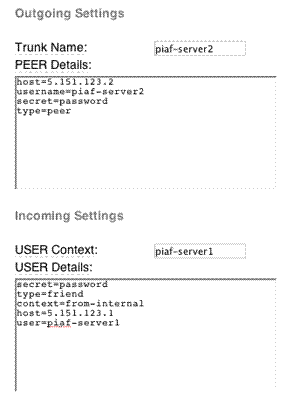
While still on piaf-server1, repeat the process to create a trunk for piaf-server3:
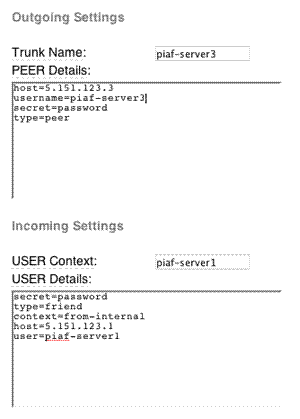
On your second server (piaf-server2 in our example), using a web browser, open FreePBX and choose Admin, Setup, Trunks and then click Add IAX2 Trunk. Create the trunk to piaf-server1 with the following entries. Leave everything blank except the entries shown below:
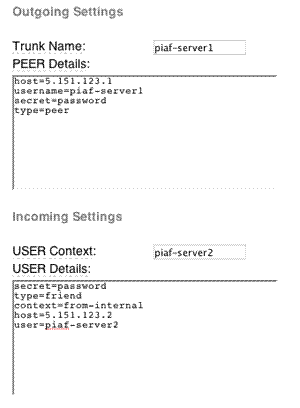
While still on piaf-server2, repeat the process to create a trunk for piaf-server3:
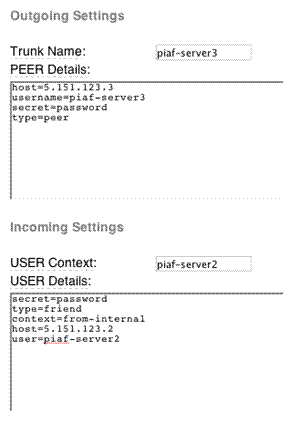
On your third server (piaf-server3 in our example), using a web browser, open FreePBX and choose Admin, Setup, Trunks and then click Add IAX2 Trunk. Create the trunk to piaf-server1 with the following entries. Leave everything blank except the entries shown below:
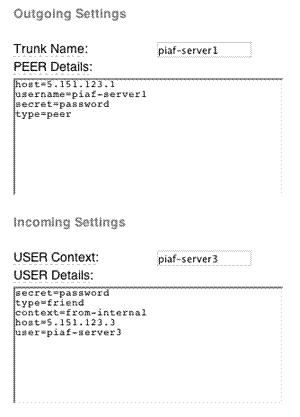
While still on piaf-server3, repeat the process to create a trunk for piaf-server2:
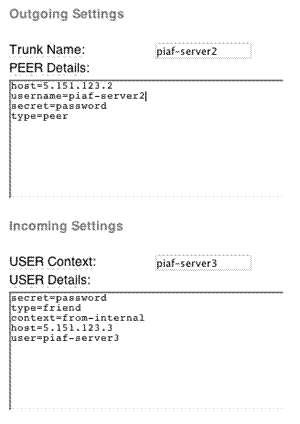
Creating Outbound Routes. Now we need to tell Asterisk how to route the calls between the servers. In a nutshell, we want calls to extensions in the 1xxx range routed to extensions on piaf-server1, calls to 2xxx extensions routed to piaf-server2, and calls to 3xxx extensions routed to piaf-server3. On each server, create an outbound route for each of the remaining servers. Name the routes server1, server2, and server3 as appropriate. The critical pieces of information in each outbound route are the dial string (which should match the extensions on the server we’re connecting to) and the Trunk Sequence (which should be the appropriate IAX trunk for the server we’re connecting to).
On piaf-server1, we’d have a server2 outbound route with a Dial String of 2xxx and a Trunk Sequence of IAX2/piaf-server2. Then we’d have another server3 route with a Dial String of 3xxx and a Trunk Sequence of IAX2/piaf-server3. If you have a catch-all outbound route, be sure to move these routes above the catch-all in the right column. Then reload your dialplan.
On piaf-server2, we’d have a server1 outbound route with a Dial String of 1xxx and a Trunk Sequence of IAX2/piaf-server1. Then we’d have another server3 route with a Dial String of 3xxx and a Trunk Sequence of IAX2/piaf-server3. If you have a catch-all outbound route, be sure to move these routes above the catch-all in the right column. Then reload your dialplan.
On piaf-server3, we’d have a server1 outbound route with a Dial String of 1xxx and a Trunk Sequence of IAX2/piaf-server1. Then we’d have another server2 route with a Dial String of 2xxx and a Trunk Sequence of IAX2/piaf-server2. If you have a catch-all outbound route, be sure to move these routes above the catch-all in the right column. Then reload your dialplan.
If you’re setting this up with PRI or T1 connections between your servers, you might also want to specify at least secondary trunk sequences for each of the outbound routes to provide some redundancy. For example, on piaf-server1, you might want a secondary Trunk Sequence for server2 that specified IAX2/piaf-server3. Then, if the primary connection between server1 and server2 was down, Asterisk would attempt to complete calls to 2xxx extensions by routing them to server3 and then on to server2 from there. To the caller and call recipient, they’d never know that the direct link between server1 and server2 had failed.
Alternate routing might also be appropriate where you have more capacity between certain servers. For example, if you had a single T1 line between server1 and server3 but you had PRI connections between server1 and server2 and between server2 and server3, then it might make more sense to indirectly route 3xxx calls from server1 through server2 and then on to server3 rather than the direct route from server1 to server3. Enjoy!

Free DIDs While They Last. Sipgate is giving away a free U.S. DID with free incoming calls plus 200 free minutes for outbound calls. Better hurry. Here’s the trunk setup for FreePBX-based systems:
Trunk name: sipgate
type=peer
username=ACCTNO
fromuser=ACCTNO
secret=ACCTPW
context=from-trunk
host=sipgate.com
fromdomain=sipgate.com
insecure=very
caninvite=no
canreinvite=no
nat=no
disallow=all
allow=ulaw&alawRegistration Strong: ACCTNO:ACCTPW@sipgate.com/YOUR-DID-NUMBER
ACCTNO is the account number assigned to your sipgate account. ACCTPW is the password for your account. YOUR-DID-NUMBER is your 10-digit DID.
Finally create an inbound route using your actual 10-digit DID and assign a destination for the inbound calls.

Need help with Asterisk? Visit the PBX in a Flash Forum.
Or Try the New, Free PBX in a Flash Conference Bridge.
Twitter Magic. If you haven’t noticed the right margin of Nerd Vittles lately, we’ve added a new link to our Twitter feed. If you explore a little, you’ll discover that the user interface now brings you instant access to every Twitter feed from the convenience of the Nerd Vittles desktop. Enjoy!
whos.amung.us If you’re wondering what your fellow man is reading on Nerd Vittles these days, wonder no more. Visit our new whos.amung.us statistical web site and check out what’s happening. It’s a terrific resource both for us and for you.
Special Thanks to Our Generous Sponsors
FULL DISCLOSURE: ClearlyIP, Skyetel, Vitelity, DigitalOcean, Vultr, VoIP.ms, 3CX, Sangoma, TelecomsXchange and VitalPBX have provided financial support to Nerd Vittles and our open source projects through advertising, referral revenue, and/or merchandise. As an Amazon Associate and Best Buy Affiliate, we also earn from qualifying purchases. We’ve chosen these providers not the other way around. Our decisions are based upon their corporate reputation and the quality of their offerings and pricing. Our recommendations regarding technology are reached without regard to financial compensation except in situations in which comparable products at comparable pricing are available from multiple sources. In this limited case, we support our sponsors because our sponsors support us.
 BOGO Bonaza: Enjoy state-of-the-art VoIP service with a $10 credit and half-price SIP service on up to $500 of Skyetel trunking with free number porting when you fund your Skyetel account. No limits on number of simultaneous calls. Quadruple data center redundancy. $25 monthly minimum spend required. Tutorial and sign up details are here.
BOGO Bonaza: Enjoy state-of-the-art VoIP service with a $10 credit and half-price SIP service on up to $500 of Skyetel trunking with free number porting when you fund your Skyetel account. No limits on number of simultaneous calls. Quadruple data center redundancy. $25 monthly minimum spend required. Tutorial and sign up details are here.
 The lynchpin of Incredible PBX 2020 and beyond is ClearlyIP components which bring management of FreePBX modules and SIP phone integration to a level never before available with any other Asterisk distribution. And now you can configure and reconfigure your new Incredible PBX phones from the convenience of the Incredible PBX GUI.
The lynchpin of Incredible PBX 2020 and beyond is ClearlyIP components which bring management of FreePBX modules and SIP phone integration to a level never before available with any other Asterisk distribution. And now you can configure and reconfigure your new Incredible PBX phones from the convenience of the Incredible PBX GUI.
 VitalPBX is perhaps the fastest-growing PBX offering based upon Asterisk with an installed presence in more than 100 countries worldwide. VitalPBX has generously provided a customized White Label version of Incredible PBX tailored for use with all Incredible PBX and VitalPBX custom applications. Follow this link for a free test drive!
VitalPBX is perhaps the fastest-growing PBX offering based upon Asterisk with an installed presence in more than 100 countries worldwide. VitalPBX has generously provided a customized White Label version of Incredible PBX tailored for use with all Incredible PBX and VitalPBX custom applications. Follow this link for a free test drive!
 Special Thanks to Vitelity. Vitelity is now Voyant Communications and has halted new registrations for the time being. Our special thanks to Vitelity for their unwavering financial support over many years and to the many Nerd Vittles readers who continue to enjoy the benefits of their service offerings. We will keep everyone posted on further developments.
Special Thanks to Vitelity. Vitelity is now Voyant Communications and has halted new registrations for the time being. Our special thanks to Vitelity for their unwavering financial support over many years and to the many Nerd Vittles readers who continue to enjoy the benefits of their service offerings. We will keep everyone posted on further developments.
Some Recent Nerd Vittles Articles of Interest…
- See comment #1 below. [↩]


 JUST RELEASED: Visit the Incredible PBX Wiki
JUST RELEASED: Visit the Incredible PBX Wiki